




We recognize your passion for providing the best care to your patients and helping them lead a long and healthy life, but we also know you must navigate through daily challenges in your practice which requires resilience.
At SEKISUI Diagnostics we are committed to providing high quality, US-made women’s health rapid tests which are accurate and easy-to-use so you can get the answers fast and your patients back to doing what they love.

Like you, we understand there is a patient behind every answer—and that’s what matters most.
For more information, call 888-616-0537, or visit us at osomtests.com
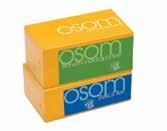
There are two simple ways to request information about the products and services found in Physicians Office Resource.
1. Go to www.PhysiciansOfficeResource.com and enter the four-digit reference number found next to the product or ser vice into the search field, then request additional information, schedule a demo, or speak with a sales agent all with just a simple click of a button.
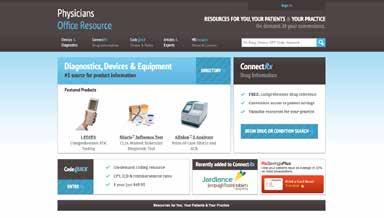
2. Find the Business Reply Card in this issue, circle the desired reference numbers, complete the form, and drop into any USPS mailbox. A representative will contact you as quickly as possible to answer your questions.
www.PhysiciansOfficeResource.com

PUBLISHED BY Medical Education Resources, LLC
PUBLISHER
Aaron R. Medaris amedaris@physiciansofficeresource.com
CEO Andrew C. Nimmo acnimmo@physiciansofficeresource.com
PRESIDENT John D. Pasquale jpasquale@pharmaconnect.com
BUSINESS MANAGER Marci J. Hills mhills@physiciansofficeresource.com
TRAVEL EDITOR Brandi L. Brower
EDITORIAL BOARD
Michael Paquin, FHIMSS Barry Craig, MLT (NCA), CLC
STAFF WRITER
Dylan J. Chadwick
CREATIVE DIRECTOR PRODUCTION MANAGER Jessica Elmer
Copyright ©2022
To continue your free subscription of Physicians Office Resource magazine, please fill out the Business Reply Card (BRC) located within this magazine and drop in any United States Post Office mailbox.
If you are a manufacturer of medical products or provide services to medical professionals and would like to advertise your products or services to the nation’s top physicians doing in-office testing, call 801-380-6094 or visit: POR.io for more information.
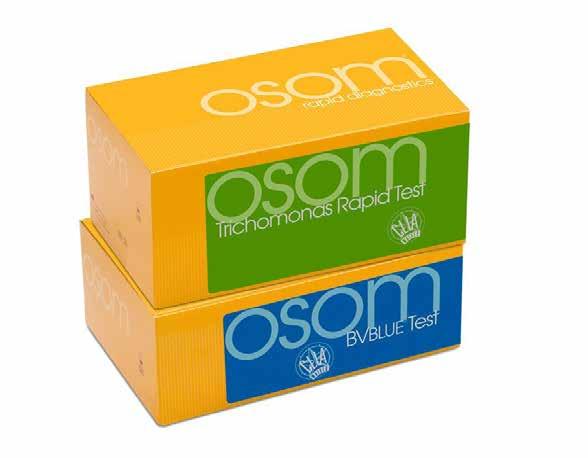
SEKISUI Diagnostics understands that it is crucial to immediately diagnose and treat vulvovaginal disorders to reduce the risk of associated health complications. The OSOM ® BVBLUE ® and Trichomonas Tests are easy-to-use, CLIA-waived tests that produce accurate and objective results for two of the most common causes of vulvovaginal disorders; Bacterial vaginosis and Trichomoniasis. The tests can be performed at the point-of-care and results are available within 10 minutes or less, allowing physicians to conduct immediate vaginal health interventions at the first patient visit.
The last couple of years as we hunkered down, masked up, social distanced, and used gallons of hand sanitizer to avoid the dreaded results of COVID-19, we also avoided the flu the and a variety of other respiratory infections.
Among U.S. physicians and healthcare professionals, personal financial matters may make things tougher given high educational debt-loads, capped income levels during residency years, and unique insurance needs.
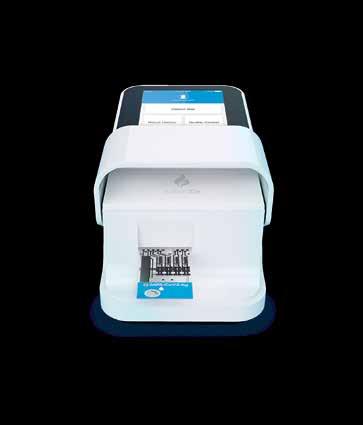
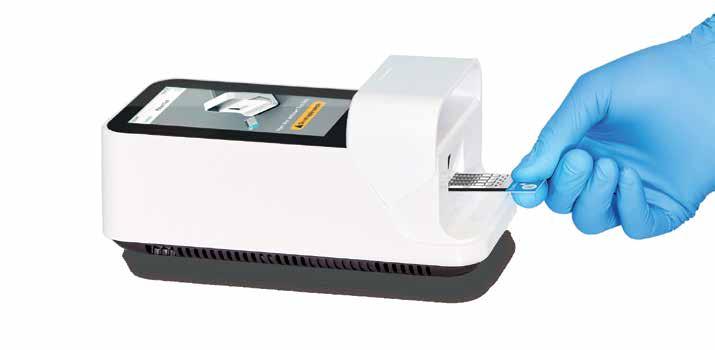


The last couple of years as we hunkered down, masked up, social distanced, and used gallons of hand sanitizer to avoid the dreaded results of COVID-19, we also avoided the flu the and a variety of other respiratory infections. Talk to any parent with young children and they’ll most likely tell you that 2020 was the healthiest their kids had been in a long time. Now that we’ve been vaccinated, eliminated social distancing, shed the masks, toned down the use of hand sanitizer, and even had the leader of the free world declare the pandemic is “over” (I personally don’t agree with that last one), multiple questions linger in my mind:
1. With a public that became accustomed to being tested for COVID seek medical care to be tested for other respiratory infections?
2. Will HCPs be willing to test for multiple respiratory viruses (ex: Flu vs. COVID)?
3. What can HCPs do to prepare themselves for this coming COVID and Flu season?
While no forecast is perfect, initial reports from states across the country are showing an increase in influen za. Some experts even estimate that the flu will outpace COVID this winter season. Assessing our current situation
and looking at the forecast, what can you do to be better prepared for the increase of patients respiratory infections that will soon be entering your exam rooms? The first and one of the most important is to test for respiratory infec tions. That may seem simple, but this important step is often skipped because well, if it looks like a duck, and it talks like a duck, well then it’s probably a duck…right? But what if there’s more to it? A couple of years ago, I got really sick. Cough, fever, chills, body aches that came on hard and fast. I went to the doctor and after his examination, he told me he has seen this a lot lately and it was just a virus. I then asked if he thought it was the flu. He quickly replied, “I highly doubt it. I haven’t seen any flu cases this year.” This illness just felt different to me, and so I asked, “Is it ok if you test me for the flu?” He again stated he was quite cer tain it wasn’t the flu, but that if I wanted the test he would have the nurse administer one. And wouldn’t you know it, when I got the test results back, I had the flu. My good doctor prescribed an antiviral which helped immensely! A treatment I would have never received if I hadn’t been test ed. Could it be that all those that my physician had been seeing with similar symptoms as I had the flu as well, but were never tested for it?
Some physicians like in the example above choose not to
test. Whether that’s because doubts regarding the accuracy of tests or feel that empirical treatment will be effective in most cases. Despite these concerns there are multiple reasons why you should test:
1. Empirical treatment can lead to more patients receiving antiviral treatment than actually need to receive it. This could possibly give rise to an antiviral shortage and delaying the correct care for another patient that actually needs it.
2. Testing frequently will provide the physician with valuable “market intelligence.” It will help the physician understand what viruses are currently spreading through the community and will allow them to provide a better treatment path.
3. Better patient experience. That might seem odd because what patient wants a stick shoved up their nose. The truth is, testing shows the patient that you want to provide the best possible care and it can bring peace of mind to the patient, even if they do test positive. They will know that they are being treated the correct way.
I’m sure that many of you are testing for respiratory in fections. If you’ve talked to your distributor lately, you’ve probably noticed a lot of different respiratory tests out there. When it comes to testing for flu, COVID, RSV, rhi novirus, etc. which test is best for you and your practice? Here are some things to consider when evaluating which ones are best for you:
CLIA Complexity – A test is only good if you are able to administer it. Make sure that you are equipped with the correct CLIA certificate of perform the test. Check to see if the test is a Waived (most simple) or Moderately complex (requires additional certification). If you’re a waived facil ity and are interested in purchasing a moderately complex test, that’s fine, but make sure you take the steps before hand to become a certified compliance facility with CLIA.
Ease of Use – Is the test simple to perform? Difficult? Re quire additional equipment? Training? Will the additional equipment help me in the long run?
Performance – Sensitivity and specificity are essential. I would even be sensitive to the brand of test that I am purchasing. Especially when it comes to different COVID tests. Due to the EUA that the FDA has granted, there are many counterfeit and poor quality COVID tests that are being pushed on doctors.
Volume – How many tests are you planning on running? What’s the average you use during a flu season? Will you need more this season?
Time to Results – How long does it take to run and receive test results? Is it important to get results back quickly to your patients?
Sample Type – is it a single sample type or does it allow for multiple sample types (nasal, nasopharyngeal, saliva, etc.)?
Connectivity – Is it important to have the results transmit ted electronically?
Cost – Brand is important when it comes to getting accurate results. But brand can also be expensive. Be sure to check with different brand reps, distributors, websites, publications, and promo emails for discounts and specials. They’re out there.
Rapid Lateral Flow Immunochemical Tests: There are different varieties of these test which have been on the market for decades and are used to confirm the presence or absence of a specific antigen. Results of these types of tests can either be viewed visually or with the use of an instrument. May of these tests are CLIA Waived and can be completed in less than 15 minutes.
Molecular Tests: Many flu and other respiratory infections can be run on molecular devices. These tests detect the presence of the genetic material of the virus and generally produce results in 30 minutes or less. Molecular results are the gold stan dard in testing. Be sure to verify the CLIA compliance that is needed for molecular tests, some are CLIA Waived and some require a moderate complexity license. CLIA Waived molecular test typically use rapid PCR detection and the device can be moved closer to the point of care. CLIA Waived molecular devices usually cost less than traditional molecular devices, but still offer the same reimbursement.
One important thing to note is that no respiratory test provides 100% accuracy. Results depend on a few different criteria: type of test used, virus strain, and integrity of the sample. For best results please review test instructions and be aware of any test limitations.
No one can predict the future, but we can look at where we’ve been and current trends. Now whether those trends will hold true is yet to play out, but I do know we can do our best to be prepared for this COVID and flu season. Physicians Office Resource offers valuable insights on a variety of different respiratory infection tests and testing devices. Look for them in this issue or visit our website and learn more. Have questions feel free to reach out and we’ll be sure to put you in contact with the right people.



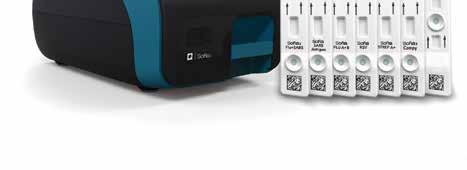
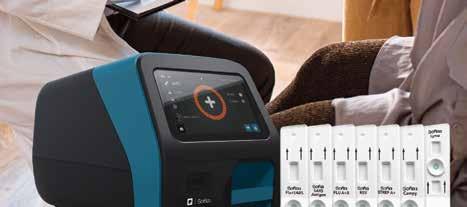

2006
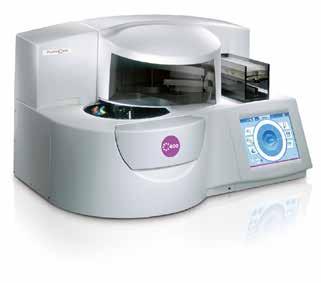
One benchtop, not a whole lab! No water system, drain or special electrical connected required to operate the Pentra C400 chemistry analyzer. Now you can have the power of a floor model analyzer on the benchtop! The Pentra C400 chemistry system processes up to 420 tests/hr including ISEs and offers routine metabolic assays, TDMs, DAUs and Adulterants, HbA1c and Vitamin D tests. With 40 open channels, you can add much more for a complete menu to meet your practice needs.
View Brochures, Videos & More at POR.io
Enter Number 2007 in the Search Area
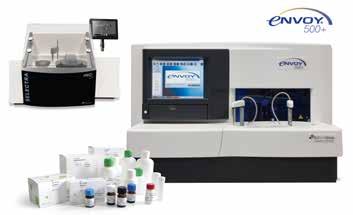
From
The fully automated Envoy500+ is designed to deliver the performance of a large floor model analyzer but provides the cost efficiency of a benchtop analyzer (TPH approx. 490). It enables accurate treatment decisions sooner. Envoy500+ delivers savings the laboratory requires with the following features positive sample and reagent identification, clot detection, liquid level sensing, dry ISE module, reusable glass cuvettes, and many more.
View Brochures, Videos & More at POR.io Enter Number 2006 in the Search Area
2007

The RX daytona+ is a fully automated, benchtop, clinical chemistry analyzer capable of performing high quality testing, with a combined throughput of 450 tests per hour, for accurate results you can trust. The most versatile analyzer in its class, the RX daytona+ combines robust hardware and intuitive software with the world leading RX series test menu for unrivaled performance, with direct HbA1c testing capabilities.
View Brochures, Videos & More at POR.io Enter Number 2008 in the Search Area
2009
®
Fast, accurate and comparable to DXA.
Bindex is the world’s first evidence-based, point-of-care osteoporosis diagnostics device that provides results comparable with DXA. Portable, hand-held and lightweight, Bindex scans in seconds and at a fraction of the cost allowing you to quickly provide much-needed osteoporosis diagnostics for your at-risk patients. NOW YOU CAN TRIAL BINDEX AT NO
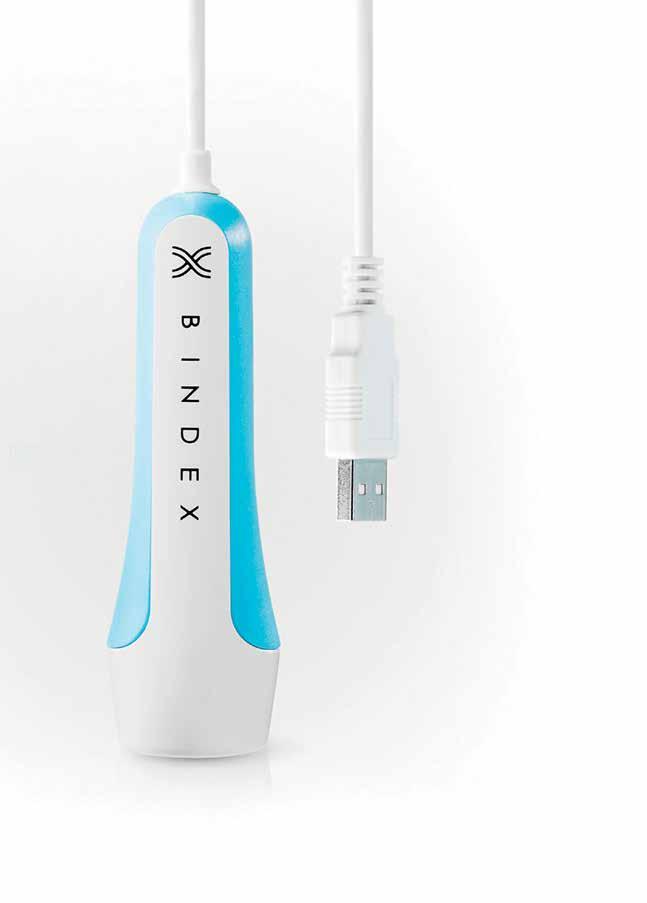
To trial Bindex in your office, visit bindex.us/launch or call (970)-306-7452.
Now there’s an
Scalp, nail, genital, and palmoplantar
Taltz is indicated for patients aged 6 years or older with moderate-to-severe plaque psoriasis (PsO) who are candidates for systemic therapy or phototherapy. Taltz is also indicated for adult patients with active psoriatic arthritis (PsA), adult patients with active ankylosing spondylitis (AS), and adult patients with active non-radiographic axial spondyloarthritis (nr-axSpA) with objective signs of inflammation.
PSSI=0 by year 5, observed Nx=173 Mean baseline PSSI=20 mNRI analysis=69% (n=349)
NAPSI=0 by year 5, observed Nx=127 Mean baseline NAPSI=27 mNRI analysis=64% (n=229)
Scalp and nail psoriasis often are predictors of a patient developing PsA18
sPGA-G 0 by year 1, NRI* n=75
Mean baseline sPGA-G=3.4
PPASI 100 by year 5, observed Nx=41
Mean baseline PPASI=10 mNRI analysis=75% (n=96)
Nail, scalp, and palmoplantar data are from an open-label extension of UNCOVER-3 and are post hoc, subgroup analyses of patients who had nail, scalp, and palmoplantar psoriasis at baseline. sPGA-G 0 was a prespecified, exploratory endpoint from an open-label extension of IXORA-Q. The open-label phase of the studies has limitations (eg, no placebo comparison, patients remaining in the extension phase may be those with better results).
*At week 12, 73% of patients taking Taltz vs 8% of patients taking placebo achieved the primary endpoint in IXORA-Q of sPGA-G 0,1.7
#1 prescribed IL-17A antagonist in Dermatology*
*Based on new prescriptions and total prescriptions, inclusive of inhibitors targeting IL-17 A/F.
Co-primary endpoint results (NRI) in UNCOVER-1 (Taltz n=433; placebo n=431), UNCOVER-2 (Taltz n=351; placebo n=168), and UNCOVER-3 (Taltz n=385; placebo n=193): 89%, 90%, and 87% of Taltz patients, respectively, achieved PASI 75 at week 12 vs 4%, 2%, and 7% for placebo. Also, 82%, 83%, and 81% of Taltz patients, respectively, achieved sPGA 0,1 at week 12 vs 3%, 2%, and 7% for placebo.8
Additional week 12 results NRI: In UNCOVER-1, UNCOVER-2, and UNCOVER-3: 35%, 40%, and 38% of Taltz patients achieved PASI 100 vs 0%, 1%, and 0% for placebo, respectively.
In the maintenance period of UNCOVER-1 and -2, among patients who achieved sPGA 0,1 at week 12 with Taltz 80 mg every 2 weeks (NRI), 75% of patients who were re-randomized to Taltz 80 mg every 4 weeks (n=181† ) and 7% of patients who were rerandomized to placebo (n=203† ) achieved sPGA 0,1 at week 60.8,9
†Evaluable patients at week 60
PSSI=Psoriasis Scalp Severity Index; mNRI=modified nonresponder imputation; NAPSI=Nail Psoriasis Severity Index; sPGA-G=static Physician’s Global Assessment of Genitalia; NRI=nonresponder imputation; PPASI=Palmoplantar Psoriasis Area Severity Index.
Taltz is contraindicated in patients with a previous serious hypersensitivity reaction, such as anaphylaxis, to ixekizumab or to any of the excipients.
Taltz may increase the risk of infection. In clinical trials of adult patients with plaque psoriasis, the Taltz group had a higher rate of infections than the placebo group (27% vs 23%). A similar increase in risk of infection was seen in placebo-controlled trials of adult patients with psoriatic arthritis, ankylosing spondylitis, non-radiographic axial spondyloarthritis, and pediatric patients with plaque psoriasis. Serious infections have occurred. Instruct patients to seek medical advice if signs or symptoms of clinically important chronic or acute infection occur. If a serious infection develops, discontinue Taltz until the infection resolves.
Pre-Treatment Evaluation for Tuberculosis
Evaluate patients for tuberculosis (TB) infection prior to initiating treatment with Taltz. Do not administer to patients with active TB infection. Initiate treatment of latent TB prior to administering Taltz. Closely monitor patients receiving Taltz for signs and symptoms of active TB during and after treatment
Serious hypersensitivity reactions, including angioedema and urticaria (each ≤0.1%), occurred in the Taltz group in clinical trials. Anaphylaxis, including cases leading to hospitalization, has been reported in post-marketing use with Taltz. If a serious
UNCOVER-1, -2, and -38,11: The Taltz plaque psoriasis clinical trial program included 3 randomized, double-blind, placebo-controlled trials to evaluate the efficacy and safety of Taltz. All patients were ≥18 years of age and had plaque psoriasis with a body surface area involvement of ≥10%, a static Physician’s Global Assessment (sPGA) score ≥3, and a Psoriasis Area and Severity Index (PASI) score ≥12, and were candidates for phototherapy or systemic therapy. Participants were randomized to receive placebo or Taltz 80 mg every 2 weeks following a 160 mg starting dose. In UNCOVER-2 and -3, an additional arm of US-approved Enbrel® (etanercept) (50 mg twice weekly) was included. Co-primary efficacy endpoints were proportion of patients with an sPGA 0,1 and at least a 2-point improvement from baseline and proportion of patients achieving PASI 75 (at least a 75% reduction in the PASI composite score) at week 12. Nonresponder imputation (NRI) methods were used for categorical efficacy analyses.
Patients originally randomized to Taltz who were responders at week 12 (ie, sPGA 0,1) in UNCOVER-1 and -2 were rerandomized to either Taltz 80 mg every 4 weeks or placebo. In UNCOVER-3, after week 12 all patients received open label Taltz 80 mg every 4 weeks. In all UNCOVER trials, any patients who relapsed (sPGA ≥3) at any time during the maintenance period were classified as nonresponders.
hypersensitivity reaction occurs, discontinue Taltz immediately and initiate appropriate therapy.
Patients treated with Taltz may be at an increased risk of inflammatory bowel disease. In clinical trials, Crohn’s disease and ulcerative colitis, including exacerbations, occurred at a greater frequency in the Taltz group than the placebo group. During Taltz treatment, monitor patients for onset or exacerbations of inflammatory bowel disease and if IBD occurs, discontinue Taltz and initiate appropriate medical management.
Prior to initiating therapy with Taltz, consider completion of all age-appropriate immunizations according to current immunization guidelines. Avoid use of live vaccines in patients treated with Taltz.
Most common adverse reactions (≥1%) associated with Taltz treatment are injection site reactions, upper respiratory tract infections, nausea, and tinea infections. Overall, the safety profiles observed in adult patients with psoriatic arthritis, ankylosing spondylitis, non-radiographic axial spondyloarthritis, and pediatric patients with plaque psoriasis were consistent with the safety profile in adult patients with plaque psoriasis, with the exception of influenza and conjunctivitis in psoriatic arthritis and conjunctivitis, influenza, and urticaria in pediatric psoriasis.
Please see Brief Summary of full Prescribing Information on the following pages. See Instructions for Use included with the device.
IX HCP ISI 07MAY2020
IXORA-Q8,10: IXORA-Q is a placebo-controlled, randomized, double-blind study comparing the efficacy and safety of Taltz vs placebo in patients with moderate to severe genital psoriasis, as measured by the proportion of patients achieving sPGA-G 0,1 at week 12 (primary endpoint).
The study enrolled 149 adult patients with plaque psoriasis who had minimum BSA of ≥1%, sPGA ≥3 (moderate psoriasis) and sPGA-G score of ≥3 (moderate genital psoriasis), who failed to respond to or were intolerant of at least one topical therapy used for treatment of psoriasis affecting the genital area (corticosteroids, calcineurin inhibitors, and/or vitamin D analogues), and who were candidates for phototherapy and/or systemic therapy. Patients were randomized to receive placebo or Taltz 80 mg ever y 2 weeks after a 160 mg starting dose. Nonresponder imputation (NRI) methods were used for categorical efficacy analyses.
References: 1. Data on file. Lilly USA, LLC. DOF-IX-US-0264. 2. Blauvelt A, Lebwohl MG, Mabuchi T, et al. Long-term efficacy and safety of ixekizumab: 5-year analysis of the UNCOVER-3 randomized controlled trial [published online ahead of print November 27, 2020]. J Am Acad Dermatol. doi:10.1016/j.aad.2020.11.022. 3. Data on file. Lilly USA, LLC. DOF-IX-US-0271. 4. Data on file. Lilly USA, LLC. DOF-IX-US-0259. 5. Data on file. Lilly USA, LLC. DOF-IX-US-0258. 6. Data on file. Lilly USA, LLC. DOFIX-US-0263. 7. Ryan C, Menter A, Guenther L, et al; on behalf of IXORA-Q Study Group. Efficacy and safety of ixekizumab in a randomized, double-blinded, placebo-controlled phase IIIb study of patients with moderate-to-severe genital psoriasis. Br J Dermatol. 2018;179:844-852. 8. Taltz [package insert]. Indianapolis, IN: Eli Lilly and Company; 2022. 9. Data on file. Lilly USA, LLC. DOF-IX-US-0274. 10. Data on file. Lilly USA, LLC. DOF-IX-US-0273. 11. Data on file. Lilly USA, LLC. DOF-IX-US-0183.
Taltz® is a registered trademark owned or licensed by Eli Lilly and Company, its subsidiaries or affiliates. PP-IX-US-5432 06/2022 ©Lilly USA, LLC 2022. All rights reserved.
Taltz® (ixekizumab) injection
Brief Summary: Consult the package insert for complete prescribing information.
Plaque Psoriasis—Taltz is indicated for the treatment of patients aged 6 years and older with moderate-to-severe plaque psoriasis who are candidates for systemic therapy or phototherapy. Psoriatic Arthritis—Taltz is indicated for the treatment of adult patients with active psoriatic arthritis.
Ankylosing Spondylitis—Taltz is indicated for the treatment of adult patients with active ankylosing spondylitis.
Non-radiographic Axial Spondyloarthritis—Taltz is indicated for the treatment of adult patients with active non-radiographic axial spondyloarthritis (nr-axSpA) with objective signs of inflammation.
Taltz is contraindicated in patients with a previous serious hypersensitivity reaction, such as anaphylaxis, to ixekizumab or to any of the excipients (Warnings and Precautions)
Infections—Taltz may increase the risk of infection. In clinical trials in adult patients with plaque psoriasis, the Taltz group had a higher rate of infections than the placebo group (27% vs 23%). Upper respiratory tract infections, oral candidiasis, conjunctivitis and tinea infections occurred more frequently in the Taltz group than in the placebo group. A similar increase in risk of infection was seen in placebo-controlled trials in patients with pediatric psoriasis, psoriatic arthritis, ankylosing spondylitis, and non-radiographic axial spondyloarthritis (Adverse Reactions) Instruct patients treated with Taltz to seek medical advice if signs or symptoms of clinically important chronic or acute infection occur. If a patient develops a serious infection or is not responding to standard therapy, monitor the patient closely and discontinue Taltz until the infection resolves.
Pre-treatment Evaluation for Tuberculosis—Evaluate patients for tuberculosis (TB) infection prior to initiating treatment with Taltz. Do not administer to patients with active TB infection. Initiate treatment of latent TB prior to administering Taltz. Consider anti-TB therapy prior to initiating Taltz in patients with a past history of latent or active TB in whom an adequate course of treatment cannot be confirmed. Patients receiving Taltz should be monitored closely for signs and symptoms of active TB during and after treatment.
Hypersensitivity—Serious hypersensitivity reactions, including angioedema and urticaria (each ≤0.1%), occurred in the Taltz group in clinical trials. Anaphylaxis, including cases leading to hospitalization, has been reported in post-marketing use with Taltz (Adverse Reactions) If a serious hypersensitivity reaction occurs, discontinue Taltz immediately and initiate appropriate therapy.
Inflammatory Bowel Disease—Patients treated with Taltz may be at an increased risk of inflammatory bowel disease. In clinical trials, Crohn’s disease and ulcerative colitis, including exacerbations, occurred at a greater frequency in the Taltz group than in the control group (Adverse Reactions). During Taltz treatment, monitor for onset or exacerbation of inflammatory bowel disease and if IBD occurs, discontinue Taltz and initiate appropriate medical management. Immunizations—Prior to initiating therapy with Taltz, consider completion of all age-appropriate immunizations according to current immunization guidelines. Avoid use of live vaccines in patients treated with Taltz. No data are available on the response to live vaccines.
The following adverse drug reactions are discussed in greater detail in other sections of the label:
•Infections (Warnings and Precautions)
•Hypersensitivity Reactions (Contraindications and Warnings and Precautions)
•Inflammatory Bowel Disease (Warnings and Precautions)
Clinical Trials Experience—Because clinical trials are conducted under widely varying and controlled conditions, adverse reaction rates observed in the clinical trials of a drug cannot be directly compared to rates in the clinical trials of another drug and may not reflect the rates observed in practice.
Adult Plaque Psoriasis
Weeks 0 to 12: Three placebo-controlled trials in subjects with plaque psoriasis were integrated to evaluate the safety of Taltz compared to placebo for up to 12 weeks. A total of 1167 subjects (mean age 45 years; 66% men; 94% White) with plaque psoriasis received Taltz (160 mg at Week 0, 80 mg every 2 weeks [Q2W] for 12 weeks) subcutaneously. In two of the trials, the safety of Taltz (use up to 12 weeks) was also compared with an active comparator, U.S. approved etanercept.
In the 12-week, placebo-controlled period, adverse events occurred in 58% of the Taltz Q2W group (2.5 per subject-year of follow-up) compared with 47% of the placebo group (2.1 per subject-year of follow-up). Serious adverse events occurred in 2% of the Taltz group (0.07 per subject-year of follow-up), and in 2% of the placebo group (0.07 per subject-year of follow-up).
Table 1 summarizes the adverse reactions that occurred at a rate of at least 1% and at a higher rate in the Taltz group than the placebo group during the 12-week placebo-controlled period of the pooled clinical trials.
Table 1: Adverse Reactions Occurring in ≥1% of the Taltz Group and More Frequently than in the Placebo Group in the Plaque Psoriasis Clinical Trials through Week 12 Adverse Reactions Taltz 80 mg Q2W (N=1167) (n%) Etanerceptb (N=287) (n%) Placebo (N=791) (n%)
Injection site reactions 196 (17)32 (11) 26 (3)
Upper respiratory tract infectionsa 163 (14)23 (8)101 (13)
Nausea 23 (2) 1 (<1) 5 (1)
Tinea infections 17 (2) 0 1 (<1)
a Upper respiratory tract infections cluster includes nasopharyngitis and rhinovirus infection.
b U.S. approved etanercept.
Adverse reactions that occurred at rates less than 1% in the Taltz group and more frequently than in the placebo group during the 12-week induction period included rhinitis, oral candidiasis, urticaria, influenza, conjunctivitis, inflammatory bowel disease, and angioedema. Weeks 13 to 60: A total of 332 subjects received the recommended maintenance regimen of Taltz 80 mg dosed every 4 weeks. During the maintenance period (Weeks 13 to 60), adverse events occurred in 80% of subjects treated with Taltz (1.0 per subject-year of follow-up) compared to 58% of subjects treated with placebo (1.1 per subject-year of follow-up). Serious adverse events were reported in 4% of subjects treated with Taltz (0.05 per subject-year of follow-up) and none in the subjects treated with placebo.
Weeks 0 to 60: Over the entire treatment period (Weeks 0 to 60), adverse events were reported in 67% of subjects treated with Taltz (1.4 per subject-year of follow-up) compared to 48% of subjects treated with placebo (2.0 per subject-year of follow-up). Serious adverse events were reported in 3% of subjects treated with Taltz (0.06 per subject-year of follow-up), and in 2% of subjects treated with placebo (0.06 per subject-year of follow-up).
Specific Adverse Drug Reactions: Injection Site Reactions: The most frequent injection site reactions were erythema and pain. Most injection site reactions were mild-to-moderate in severity and did not lead to discontinuation of Taltz.
Infections: In the 12-week, placebo-controlled period of the clinical trials in plaque psoriasis, infections occurred in 27% of subjects treated with Taltz (1.2 per subject-year of follow-up) compared to 23% of subjects treated with placebo (1.0 per subject-year of follow-up). Serious infections occurred in 0.4% of subjects treated with Taltz (0.02 per subject-year of follow-up) and in 0.4% of subjects treated with placebo (0.02 per subject-year of follow-up) (Warnings and Precautions)
During the maintenance treatment period (Weeks 13 to 60), infections occurred in 57% of subjects treated with Taltz (0.70 per subject-year of follow-up) compared to 32% of subjects treated with placebo (0.61 per subject-year of follow-up). Serious infections occurred in 0.9% of subjects treated with Taltz (0.01 per subject-year of follow-up) and none in the subjects treated with placebo.
Over the entire treatment period (Weeks 0 to 60), infections were reported in 38% of subjects treated with Taltz (0.83 per subject-year of follow-up) compared to 23% of subjects treated with placebo (1.0 per subject-year of follow-up). Serious infections occurred in 0.7% of subjects treated with Taltz (0.02 per subject-year of follow-up), and in 0.4% of subject treated with placebo (0.02 per subject-year of follow-up).
Inflammatory Bowel Disease: In adult subjects with plaque psoriasis, Crohn’s disease and ulcerative colitis, including exacerbations, occurred at a greater frequency in the TALTZ 80 mg Q2W group (Crohn’s disease 0.1%, ulcerative colitis 0.2%) than the placebo group (0%) during the 12-week, placebo-controlled period in clinical trials (Warnings and Precautions).
Laboratory Assessment of Cytopenia: Neutropenia—Over the entire treatment period (Weeks 0 to 60), neutropenia occurred in 11% of subjects treated with Taltz (0.24 per subject-year of follow-up) compared to 3% of subjects treated with placebo (0.14 per subject-year of follow-up). In subjects treated with Taltz, the incidence rate of neutropenia during Weeks 13 to 60 was lower than the incidence rate during Weeks 0 to 12.
In the 12-week, placebo-controlled period, neutropenia ≥ Grade 3 (<1,000 cells/mm3) occurred in 0.2% of the Taltz group (0.007 per subject-year of follow-up) compared to 0.1% of the placebo group (0.006 per subject-year of follow-up). The majority of cases of neutropenia were either Grade 2 (2% for Taltz 80 mg Q2W versus 0.3% for placebo; ≥1,000 to <1,500 cells/mm3) or Grade 1 (7% for Taltz 80 mg Q2W versus 3% for placebo; ≥1,500 cells/mm3 to <2,000 cells/mm3). Neutropenia in the Taltz group was not associated with an increased rate of infection compared to the placebo group.
Thrombocytopenia—Ninety eight percent of cases of thrombocytopenia were Grade 1 (3% for Taltz 80 mg Q2W versus 1% for placebo; ≥75,000 cells/mm3 to <150,000 cells/mm3). Thrombocytopenia in subjects treated with Taltz was not associated with an increased rate of bleeding compared to subjects treated with placebo.
Active Comparator Trials: In the two clinical trials that included an active comparator, the rate of serious adverse events during weeks zero to twelve was 0.7% for U.S.-approved etanercept and 2% for Taltz 80 mg Q2W, and the rate of discontinuation from adverse events was 0.7% for U.S. approved etanercept and 2% for Taltz 80 mg Q2W. The incidence of infections was 18% for U.S. approved etanercept and 26% for Taltz 80 mg Q2W. The rate of serious infections was 0.3% for both Taltz 80 mg Q2W and U.S. approved etanercept.
Taltz was evaluated in a placebo-controlled trial in pediatric subjects with moderate-to-severe psoriasis 6 to less than 18 years of age. A total of 171 subjects were studied (115 subjects on Taltz and 56 subjects on placebo). Overall, the safety profile observed in pediatric subjects with plaque psoriasis treated with Taltz every 4 weeks is consistent with the safety profile in adult subjects with plaque psoriasis with the exception of the frequencies of conjunctivitis (2.6%), influenza (1.7%), and urticaria (1.7%).
In this clinical trial, Crohn’s disease occurred at a greater frequency in the Taltz group (0.9%) than the placebo group (0%) during the 12-week, placebo-controlled period. Crohn’s disease occurred in a total of 4 Taltz treated subjects (2.0%) in the clinical trial (Warnings and Precautions).
Taltz was studied in two placebo-controlled trials in patients with psoriatic arthritis. A total of 678 patients were studied (454 patients on Taltz and 224 on placebo). A total of 229 patients in these trials received Taltz 160 mg at Week 0, followed by 80 mg every 4 weeks (Q4W). Overall, the safety profile observed in patients with psoriatic arthritis treated with Taltz Q4W is consistent with the safety profile in adult patients with plaque psoriasis with the exception of the frequencies of influenza (1.3%) and conjunctivitis (1.3%).
Taltz was studied in two placebo-controlled trials in patients with ankylosing spondylitis. A total of 566 patients were studied (376 patients on Taltz and 190 on placebo). A total of 195 patients in these trials received Taltz 80 or 160 mg at Week 0, followed by 80 mg every 4 weeks (Q4W). Overall, the safety profile observed in patients with ankylosing spondylitis treated with Taltz Q4W is consistent with the safety profile in adult patients with plaque psoriasis.
In adult patients with ankylosing spondylitis, Crohn’s disease and ulcerative colitis, including exacerbations, occurred in 2 patients (1.0%) and 1 patient (0.5%), respectively, in the Taltz 80 mg Q4W group and 1 patient (0.5%) and 0%, respectively, in the placebo group during the 16-week, placebo-controlled period in clinical trials. Of these patients, serious events occurred in 1 patient in the Taltz 80 mg Q4W group and 1 patient in the placebo group (Warnings and Precautions).
Taltz was studied in a placebo-controlled trial in patients with non-radiographic axial spondyloarthritis. A total of 303 patients were studied (198 patients on Taltz and 105 on placebo). A total of 96 patients in this trial received Taltz 80 or 160 mg at Week 0, followed by 80 mg every 4 weeks (Q4W). Overall, the safety profile observed in patients with non-radiographic axial spondyloarthritis treated with Taltz 80 mg Q4W up to Week 16 is consistent with the previous experience of Taltz in other indications.
Immunogenicity—As with all therapeutic proteins, there is the potential for immunogenicity with Taltz. The assay to test for neutralizing antibodies has limitations detecting neutralizing antibodies in the presence of ixekizumab; therefore, the incidence of neutralizing antibodies development could be underestimated.
By Week 12, approximately 9% of adult subjects treated with Taltz every 2 weeks developed antibodies to ixekizumab. Approximately 22% of subjects treated with Taltz at the recommended dosing regimen developed antibodies to ixekizumab during the 60-week treatment period. The clinical effects of antibodies to ixekizumab are dependent on the antibody titer; higher antibody titers were associated with decreasing drug concentration and clinical response.
Of the adult subjects who developed antibodies to ixekizumab during the 60-week treatment period, approximately 10%, which equates to 2% of subjects treated with Taltz at the recommended dosing regimen, had antibodies that were classified as neutralizing. Neutralizing antibodies were associated with reduced drug concentrations and loss of efficacy.
In pediatric psoriasis subjects treated with ixekizumab at the recommended dosing regimen up to 12 weeks, 21 subjects (18%) developed anti-drug antibodies, 5 subjects (4%) had confirmed neutralizing antibodies associated with low drug concentrations. No conclusive evidence could be obtained on the potential association of neutralizing antibodies and clinical response and/or adverse events due to small number of pediatric subjects in the study.
For subjects treated with Taltz 80 mg every 4 weeks for up to 52 weeks (PsA1), 11% developed anti-drug antibodies, and 8% had confirmed neutralizing antibodies.
For patients treated with Taltz 80 mg every 4 weeks for up to 16 weeks (AS1, AS2), 5.2% developed anti-drug antibodies, and 1.5% had neutralizing antibodies.
Of patients treated with Taltz 80 mg every 4 weeks for up to 52 weeks (nr-axSpA1), 8.9% developed anti-drug antibodies, all of which were low titer. No patient had neutralizing antibodies.
The detection of antibody formation is highly dependent on the sensitivity and specificity of the assay. Additionally, the observed incidence of antibody (including neutralizing antibody) positivity in an assay may be influenced by several factors including assay methodology, sample handling, timing of sample collection, concomitant medications, and underlying disease. For these reasons, comparison of incidence of antibodies to Taltz across indications or with the incidences of antibodies to other products may be misleading.
Postmarketing Experience—The following adverse reactions have been identified during post-approval use of Taltz. Because the reactions are reported voluntarily from a population of uncertain size, it is not always possible to reliably estimate their frequency or establish a causal relationship to Taltz exposure.
Immune system disorders: anaphylaxis (Contraindications and Warnings and Precautions)
There is a pregnancy exposure registry that monitors pregnancy outcomes in women exposed to Taltz during pregnancy. Pregnant women should be encouraged to enroll themselves in the registry by calling 1-800-284-1695.
Risk Summary—There are no available data on Taltz use in pregnant women to inform any drug associated risks. Human IgG is known to cross the placental barrier; therefore, Taltz may be transmitted from the mother to the developing fetus. An embryofetal development study conducted in pregnant monkeys at doses up to 19 times the maximum recommended human dose (MRHD) revealed no evidence of harm to the developing fetus. When dosing was continued until parturition, neonatal deaths were observed at 1.9 times the MRHD [see Data]. The clinical significance of these nonclinical findings is unknown.
The background risk of major birth defects and miscarriage for the indicated population is unknown. In the U.S. general population, the estimated background risk of major birth defects and miscarriage in clinically recognized pregnancies is 2 to 4% and 15 to 20%, respectively. Data
Animal Data—An embryofetal development study was conducted in cynomolgus monkeys administered ixekizumab. No malformations or embryofetal toxicity were observed in fetuses from pregnant monkeys administered ixekizumab weekly by subcutaneous injection during organogenesis to near parturition at doses up to 19 times the MRHD (on a mg/kg basis of 50 mg/kg/week). Ixekizumab crossed the placenta in monkeys.
In a pre- and post-natal development toxicity study, pregnant cynomolgus monkeys were administered weekly subcutaneous doses of ixekizumab up to 19 times the MRHD from the beginning of organogenesis to parturition. Neonatal deaths occurred in the offspring of two monkeys administered ixekizumab at 1.9 times the MRHD (on a mg/kg basis of 5 mg/kg/week) and two monkeys administered ixekizumab at 19 times the MRHD (on a mg/kg basis of 50 mg/kg/week).
These neonatal deaths were attributed to early delivery, trauma, or congenital defect. The clinical significance of these findings is unknown. No ixekizumab-related effects on functional or immunological development were observed in the infants from birth through 6 months of age.
Lactation Risk Summary—There are no data on the presence of ixekizumab in human milk, the effects on the breastfed infant, or the effects on milk production. Ixekizumab was detected in the milk of lactating cynomolgus monkeys. The developmental and health benefits of breastfeeding should be considered along with the mother’s clinical need for Taltz and any potential adverse effects on the breastfed infant from Taltz or from the underlying maternal condition.
Pediatric Use—The safety and effectiveness of Taltz have been established in pediatric subjects aged 6 years to less than 18 years with moderate-to-severe plaque psoriasis. The safety and effectiveness of Taltz in other pediatric indications and for pediatric subjects less than 6 years of age have not been established.
Geriatric Use—Of the 4204 psoriasis subjects exposed to Taltz, a total of 301 were 65 years or older, and 36 subjects were 75 years or older. Although no differences in safety or efficacy were observed between older and younger subjects, the number of subjects aged 65 and over is not sufficient to determine whether they respond differently from younger subjects.
PATIENT COUNSELING INFORMATION—Advise the patient and/or caregiver to read the FDAapproved patient labeling (Medication Guide and Instructions for Use) before the patient starts using Taltz and each time the prescription is renewed, as there may be new information they need to know.
Instructions on Self-Administration: Provide guidance to patients and caregivers on proper subcutaneous injection technique, including aseptic technique, and how to use the autoinjector or prefilled syringe correctly (Instructions for Use)
Infection: Inform patients that Taltz may lower the ability of their immune system to fight infections. Instruct patients of the importance of communicating any history of infections to the healthcare provider, and contacting their healthcare provider if they develop any symptoms of infection (Warnings and Precautions).
Allergic Reactions: Advise patients to seek immediate medical attention if they experience any symptoms of serious hypersensitivity reactions (Warnings and Precautions).
Pregnancy: Advise patients that there is a pregnancy exposure registry that monitors pregnancy outcomes in women exposed to Taltz during pregnancy. Advise patients to contact the registry at 1-800-284-1695 to enroll (Use in Specific Populations)
Additional information can be found at www.Taltz.com.
See Instructions for Use accompanying the product device.
Taltz® (ixekizumab) injection IX HCP BS 06JAN2022Taltz® (ixekizumab) injection

With emerging technological innovations in healthcare, including smartphone apps, biosensors, lab-on-a chip, and wearable devices—all of which offer a closer connection to the patient—point-of-care (POC) technologies are quickly becom ing part of the transformation of the healthcare landscape. The driving concept in support of point-of-care testing (POCT) is to bring testing closer to the patient and results conveniently and quickly to the provider to expedite diagnosis and subse quent treatment. POCT allows for faster clinical decisions in hospitals, physicians’ offices, ambulances, patient homes, and in the field.
The College of American Pathologists (CAP) defines POCT as “testing that is performed near or at the site of a patient with the result leading to a possible change in the care of the patient.”
POCT’s popularity has risen in recent years due to its conve nience, timeliness, and potential to improve patient outcomes. In fact, POCT is estimated to be increasing at 10-12% annually, compared to a 6-7% annual increase for other clinical labora tory testing. Used appropriately, POCT can be a key compo nent in meeting the goals of simultaneously improving patient outcomes and reducing healthcare costs.
Hundreds of tests once considered too complex for POCT are now routinely performed outside the laboratory. Sensor tech nologies enable the rapid analysis of blood samples for many critical care assays, includingi :
• Blood gases/electrolytes
• Cardiac markers
• Cholesterol/lipids
• Coagulation monitoring (INR; ACT, Heparin; Hemostasis Assessment)
• Drugs of abuse testing (DOA)
• Fecal occult blood
• Glucose monitoring; Hemoglobin A1C
• Hematology
• Infectious diseases (such as Influenza and Rapid Strep)
• Pregnancy and fertility
• Tumor/cancer markers
• Urinalysis testing
• Other Chemistries (Magnesium, Lactate, Micro-albumin, Creatinine)
• D-dimer for thromboembolism
In the core lab, errors occur most frequently in the pre- and post-analytic phases, however, POCT errors occur primarily
in the analytic phase of testing. This is related to a lack of understanding or training of non-laboratory staff who are involved in POCT. In addition, there are possible test lim itations and misuse in a particular environment. This often raises concern over the reliability of test results.
More than ever, the laboratory must be proactive in mon itoring all aspects of POCT, if quality care is to be main tained. These actions include:
• All Point of Care (POC) testing personnel must be properly trained, and have their competency periodically assessed, even if all their testing is waived
• All instruments involved should be used in accordance with manufacturer’s requirements with quality control, calibration, and maintenance records monitored;
• Test results must be verified as to accuracy and (if previously patient tested) consistent with a patient’s history
• Reagent storage and handling must be monitored
• Utilization of split sampling and proficiency testing is recommended for monitoring quality.
Mindful that POC testing may be performed by non-labo ratory staff, laboratories often have a staff tech responsible for monitoring this testing, acting as both a liaison, as well as a technical resource for the POC testing staff.
This is an important responsibility, as feedback from the field to the laboratory is needed to identify potential com munication problems, complaints, and the needs of both patients and staff.
The bottom line is that there should be no difference in the quality of patient care provided by the laboratory, whether performed within the confines of the laboratory itself, or anywhere else. Ultimate responsibility lies with the labora tory administration and staff.
Interdisciplinary POC management teams that include the laboratory, physicians, and nurses are considered as the most effective way to ensure the best oversight. This model increases the probability of inter-departmental cooperation and buy-in by non-lab staff of all the procedures required to assure quality POCT. They would be responsible for:
• Determining the test menu
• Selecting methodologies
• Establishing policies and procedures
• Confirming proper training and competency assessment
• Overseeing regulatory compliance
• Documenting corrective action where necessary
• Providing advisory assistance to the users of POC technologies
However, regulatory standards hold the Laboratory Direc tor ultimately responsible for managing and supervising POCT
Compliance strategies in the digital age: The Use of Data Management Systemsv
Technology has now enabled us to monitor all aspects of POCT remotely, from test requests to test results; from QC to maintenance records to documentation of competency to operate instruments. When possible, use digitalized monitoring to ensure quality work. Here is a sampling of the capabilities of remote monitoring:
Training & Competency Assessments
Documentation of the initial training, as required by CLIA and Accreditation organizations, prior to POC testing, fol lowed by documented competency assessments at specific intervals.
Quality and Compliance
• QC limits and frequency intervals can be configured on the test instrument or managed remotely through a data management system.
• Data systems can prevent an operator from using the instrument once the QC interval has been exceeded or the result is not within acceptable limits.
• QC results for each test instrument and operator can be reviewed and evaluated remotely by laboratory personnel
• Documentation of comments describing corrective action for unacceptable QC results
• Some data management systems allow incorporation of manual QC results.
Instrument Use
• Monitoring instrument use through access control and electronic communication with a laboratory information system (LIS) or other network system. This communication also allows the LIS to download quality control and patient results.
• POC testing can be set up and configured remotely from a single central location with software updates manually or automatically downloaded to the instruments.
• The data management system can serve as a repository for testing locations, instrument serial numbers, and instrument service history and software versions.
• The data management system can also track the status of the connected test instruments so that communication
and connectivity issues can be addressed promptly.
• Access to a POCT device can be authorized via operator list downloads when the instrument queries the data management system to determine whether a particular operator is authorized.
• If an unauthorized operator attempts to use the POCT instrument, he or she will be locked out, preventing use.
• In order to comply with accreditation standards, POCT coordinators can monitor data from activities such as correlation testing, linearity and analytical measurement range verification, proficiency testing, calibration, and patient identification.
• Data systems can automatically capture this data and document it for review. This data also can be entered by hand from manual tests (e.g. fecal occult blood, dipstick urine, pregnancy tests as well.
• Reagent and control lot numbers, and established QC ranges, can be entered into the data system and uploaded to the POCT instruments.
• Alarms can be set to alert the POCT coordinator when new lots are in use that may require validation
• Many POCT devices include barcode scanning capabilities that allow reagents and controls to be scanned by operators to verify the current lot number and prevent use of expired or un-validated reagents.
• The current lot numbers may reside in the data management system.
• Enables POCT data management from any computers within or outside of the organization, based on how the system is configured.
Note: to ensure quality management of POCT results, and earn the confidence of the medical staff, each of these activities must be continuously monitored, whether accomplished manually, or through the use of data management systems.
Technological advances have resulted in an explosion in the number of tests that can be performed outside the laboratory setting; locations include operating rooms, nursing homes, the workplace, private homes, retail settings, and remote field sites. More than ever, the laboratory must be proactive in monitoring this, if quality care is to be maintained.
This means that all Point of Care (POC) testing personnel must
be properly trained (and the training documented), have their competency periodically assessed, even if all their testing is waived; all instruments involved should be used in accordance with manufacturer’s requirements with quality control, cali bration, and maintenance records monitored; and test results verified as to accuracy and (if the patient has been previously tested) consistent with a patient’s history. Monitor reagent storage and handling as well. Recommended is the utilization of split sampling as well as proficiency testing, as part of Good Laboratory Practice.
Many laboratories, mindful that POC testing may be per formed by non-laboratory staff, often have a staff tech respon sible for monitoring this testing, acting as both a liaison to the laboratory as well as a technical resource for the POC testing staff. The alternative is the utilization of POCT Management Teams.
The bottom line is that there should be no difference in the quality of patient care provided by the laboratory, whether per formed within the confines of the laboratory itself, or anywhere else. Ultimate responsibility lies with the laboratory adminis tration and staff.
Irwin Z. Rothenberg is a Technical Writer/Quality Advisor for COLA’s Educational subsidiary, COLA Resources, Inc. (CRI), a leader in online continuing education for physicians, laboratory personnel, and allied health professionals. CRI offers continuing education through online courses, informational products in both electronic and hard copy form, webinars on cutting-edge technology and regulatory issues, and CRI on-site Symposia for Clinical Laboratories, providing live educational sessions and interactive workshops with leading industry organizations. For more information, visit their website at www.criedu.org or call 1-800-981-9883.
1 Futrell, K. Laboratory Point of Care Testing: A Future Outlook. POCT Progression and the Importance of Connectivity Orchard Software Whitepaper. June 2015. http://www.orchardsoft.com/files/white_paper_lab_ poc_testing.pdf
2 Futrell, K. POCT: POCT Supports New Demands. Changes in healthcare open door for point-of-care testing to improve outcomes. December 9, 2013. http:// laboratory-manager.advanceweb.com/Archives/ArticleArchives/POCT-POCT-Supports-New-Demands.aspx
3 Camacho-Ryan, O., Belthof, RL. Monitoring Point of Care Testing Compliance. Clinical Laboratory News. February 1, 2016. https://www.aacc.org/publications/cln/ articles/2016/february/monitoring-point-of-care-testingcompliance
2010
WHY COMPROMISE? FAST AND RELIABLE RESULTS ARE NOW DELIVERED AT THE POINT OF CARE.
From LumiraDx
Introducing the next generation in point-of-care diagnostics. With a growing menu of tests, LumiraDx uses a simple process that allows for more time with your patients by using microfluidic technology that delivers results in minutes. Learn more about rapid COVID-19 diagnostic solutions for your physician office at LumiraDx.com.
View Brochures, Videos & More at POR.io Enter Number 2010 in the Search Area
CARESTART™ COVID-19 ANTIGEN TEST
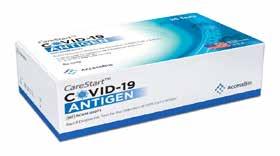
From Mercedes Scientific®
This point-of-care (POC) designated test is one of the top-used amongst our customers.
Features/Benefits:
• CLIA WAIVED
• Results within 15 minutes
• Anterior nasal swab specimen collection
• Detects SARS-CoV-2 nucleocapsid protein antigen
• 87.2% sensitivity and 100% specificity
This test is not FDA cleared or approved. This test has been authorized by FDA under an EUA for use by authorized laboratories.
View Brochures, Videos & More at POR.io Enter Number 2011 in the Search Area
2012
2011
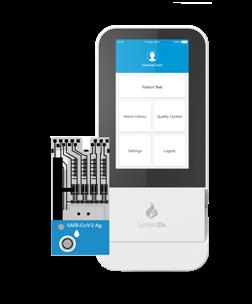
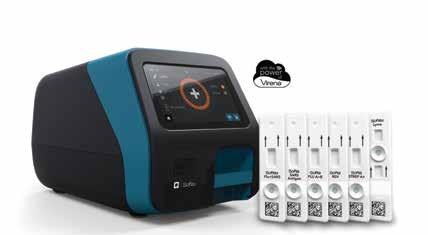
SOFIA® 2 FLUORESCENT IMMUNOASSAY ANALYZER AND RAPID DIAGNOSTIC TEST KITS
From Quidel
Sofia® 2 Fluorescent Immunoassay Analyzer and Rapid Diagnostic Test Kits Sofia 2 takes rapid testing to a new level. Proven lateral-flow technology and advanced fluorescent chemistry are all integrated into this small benchtop analyzer which can be used in any point-of-care setting. Sofia 2 kits are easy to use and adaptable to any healthcare setting. Excellent performance, objectivity, quality control, LIS capabilities, and an expanding test menu make Sofia 2 the perfect solution for the physician’s office laboratory.
View Brochures, Videos & More at POR.io Enter Number 2012 in the Search Area

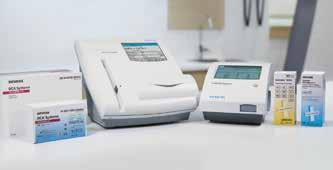
2015
COMPREHENSIVE IN-OFFICE DIABETES TESTING WITH THE DCA VANTAGE® AND CLINITEK STATUS®+ ANALYZERS

From Siemens Healthineers
Siemens Healthineers DCA Vantage® and CLINITEK Status® family of analyzers provide hemoglobin A1c (HbA1c) and albuminto-creatinine ratio (ACR) testing at the point of care. Meet quality measures for A1c control and kidney disease check in minutes with CLIA-waived HbA1c testing and ACR1 ratio. Improve patient experience and overall outcome by providing actionable results in minutes.
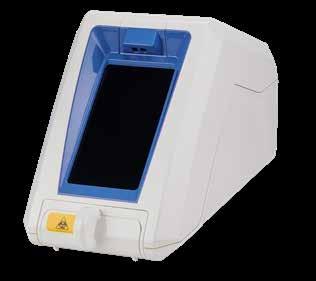

1. Moderately complex on the DCA Vantage Analyzer. CLIA-waived on the CLINITEK Status+ Analyzer.
View Brochures, Videos & More at POR.io Enter Number 2015 in the Search Area
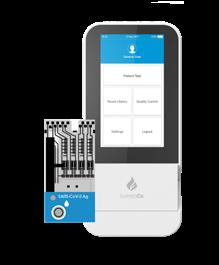
The Acucy™ Influenza A&B Test is for the rapid, qualitative detection of influenza A and B viral nucleoprotein antigens from both nasal and nasopharyngeal swabs. Utilizing the Acucy™ Reader in either the point-of-care or laboratory setting, workflow flexibility is achieved with both Read Now and Walk Away features. The combination provides clinicians with standardized and definitive result interpretation.
View Brochures, Videos & More at POR.io Enter Number 2016 in the Search Area 2016
2017
AT THE POINT OF CARE.
From LumiraDx
Introducing the next generation in point-of-care diagnostics. With a growing menu of tests, LumiraDx uses a simple process that allows for more time with your patients by using microfluidic technology that delivers results in minutes. Learn more about rapid COVID-19 diagnostic solutions for your physician office at LumiraDx.com.
View Brochures, Videos & More at POR.io Enter Number 2017 in the Search Area
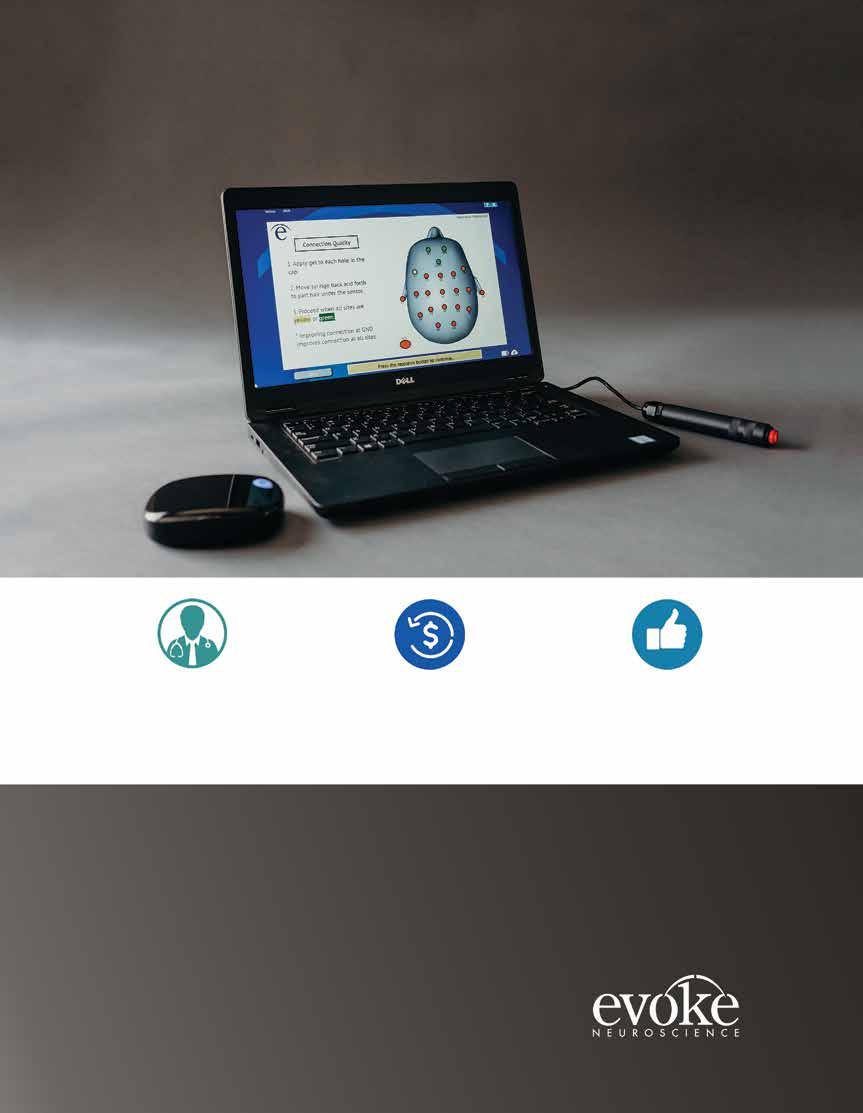



With
NUCALA is for the:
• add-on maintenance treatment of patients 6+ with SEA. Not for acute bronchospasm or status asthmaticus.
• add-on maintenance treatment of CRSwNP in patients 18+ with inadequate response to nasal corticosteroids.
• treatment of adult patients with EGPA.
• treatment of patients aged 12+ with HES for ≥6 months without an identifiable non-hematologic secondary cause.


NUCALA should not be administered to patients with a history of hypersensitivity to mepolizumab or excipients in the formulation.
Hypersensitivity reactions (eg, anaphylaxis, angioedema, bronchospasm, hypotension, urticaria, rash) have occurred with NUCALA. These reactions generally occur within hours of administration but can have a delayed onset (ie, days). If a hypersensitivity reaction occurs, discontinue NUCALA.
Acute Asthma Symptoms or Deteriorating Disease
NUCALA should not be used to treat acute asthma symptoms, acute exacerbations, or acute bronchospasm.
Opportunistic Infections: Herpes Zoster
Herpes zoster infections have occurred in patients receiving NUCALA. Consider vaccination if medically appropriate.
Do not discontinue systemic or inhaled corticosteroids abruptly upon initiation of therapy with NUCALA. Decreases in corticosteroid doses, if appropriate, should be gradual and under the direct supervision of a physician. Reduction in corticosteroid dose may be associated with systemic withdrawal symptoms and/or unmask conditions previously suppressed by systemic corticosteroid therapy.
Treat patients with pre-existing helminth infections before initiating therapy with NUCALA. If patients become infected while receiving NUCALA and do not respond to anti-helminth treatment, discontinue NUCALA until infection resolves.
Most common adverse reactions (≥5%) in patients receiving NUCALA:
• Severe asthma trials: headache, injection site reaction, back pain, fatigue
• CRSwNP trial: oropharyngeal pain, arthralgia
• EGPA and HES trials (300 mg of NUCALA): no additional adverse reactions were identified to those reported in severe asthma clinical trials
Systemic reactions, including hypersensitivity, occurred in clinical trials in patients receiving NUCALA. Manifestations included rash, pruritus, headache, myalgia, flushing, urticaria, erythema, fatigue, hypertension, warm sensation in trunk and neck, cold extremities, dyspnea, stridor, angioedema, and multifocal skin reaction. A majority of systemic reactions were experienced the day of dosing.
A pregnancy exposure registry monitors pregnancy outcomes in women with asthma exposed to NUCALA during pregnancy. To enroll call 1-877-311-8972 or visit www.mothertobaby.org/asthma.
The data on pregnancy exposures are insufficient to inform on drug-associated risk. Monoclonal antibodies, such as mepolizumab, are transported across the placenta in a linear fashion as the pregnancy progresses; therefore, potential effects on a fetus are likely to be greater during the second and third trimesters.
Trademarks are owned by or licensed to the GSK group of companies.
©2022 GSK or licensor.
Please see Brief Summary of Prescribing Information for NUCALA on the following pages.
MPLJRNA220004 August 2022 Produced in USA.
NUCALA (mepolizumab) for injection, for subcutaneous use
NUCALA (mepolizumab) injection, for subcutaneous use
The following is a brief summary only; see full prescribing information for complete product information.
1.1
NUCALA is indicated for the add-on maintenance treatment of adult and pediatric patients aged 6 years and older with severe asthma and with an eosinophilic phenotype [see Use in Specific Populations (8.4) and Clinical Studies (14.1) of full prescribing information]
NUCALA is not indicated for the relief of acute bronchospasm or status asthmaticus.
1.2
NUCALA is indicated for the add-on maintenance treatment of chronic rhinosinusitis with nasal polyps (CRSwNP) in adult patients 18 years of age and older with inadequate response to nasal corticosteroids.
NUCALA is indicated for the treatment of adult patients with eosinophilic granulomatosis with polyangiitis (EGPA).
1.4
NUCALA is indicated for the treatment of adult and pediatric patients aged 12 years and older with hypereosinophilic syndrome (HES) for ≥6 months without an identifiable non-hematologic secondary cause.
NUCALA is contraindicated in patients with a history of hypersensitivity to mepolizumab or excipients in the formulation [see Warnings and Precautions (5.1) and Description (11) of full prescribing information]
5.1
Hypersensitivity reactions (e.g., anaphylaxis, angioedema, bronchospasm, hypotension, urticaria, rash) have occurred following administration of NUCALA. These reactions generally occur within hours of administration, but in some instances can have a delayed onset (i.e., days). In the event of a hypersensitivity reaction, NUCALA should be discontinued [see Contraindications (4)]
5.2
NUCALA should not be used to treat acute asthma symptoms or acute exacerbations. Do not use NUCALA to treat acute bronchospasm or status asthmaticus. Patients should seek medical advice if their asthma remains uncontrolled or worsens after initiation of treatment with NUCALA.
5.3 Opportunistic Infections: Herpes Zoster
Herpes zoster has occurred in subjects receiving NUCALA 100 mg in controlled clinical trials [see Adverse Reactions (6.1)]. Consider vaccination if medically appropriate.
5.4
Do not discontinue systemic or inhaled corticosteroids (ICS) abruptly upon initiation of therapy with NUCALA. Reductions in corticosteroid dosage, if appropriate, should be gradual and performed under the direct supervision of a physician. Reduction in corticosteroid dosage may be associated with systemic withdrawal symptoms and/or unmask conditions previously suppressed by systemic corticosteroid therapy.
5.5
Eosinophils may be involved in the immunological response to some helminth infections. Patients with known parasitic infections were excluded from participation in clinical trials. It is unknown if NUCALA will influence a patient’s response against parasitic infections. Treat patients with pre-existing helminth infections before initiating therapy with NUCALA. If patients become infected while receiving treatment with NUCALA and do not respond to anti-helminth treatment, discontinue treatment with NUCALA until infection resolves.
The following adverse reactions are described in greater detail in other sections:
• Hypersensitivity reactions [see Warnings and Precautions (5.1)]
• Opportunistic infections: herpes zoster [see Warnings and Precautions (5.3)] Because clinical trials are conducted under widely varying conditions, adverse reaction rates observed in the clinical trials of a drug cannot be directly compared with rates in the clinical trials of another drug and may not reflect the rates observed in practice.
Adult
A total of 1,327 patients with severe asthma were evaluated in 3 randomized, placebo-controlled, multicenter trials of 24 to 52 weeks’ duration (Trial 1, NCT01000506; Trial 2, NCT01691521; and Trial 3, NCT01691508). Of these, 1,192 had a history of 2 or more exacerbations in the year prior to enrollment despite regular use of high-dose ICS plus additional controller(s) (Trials 1 and 2), and 135 patients required daily oral corticosteroids (OCS) in addition to regular use of highdose ICS plus additional controller(s) to maintain asthma control (Trial 3). All
patients had markers of eosinophilic airway inflammation [see Clinical Studies (14.1) of full prescribing information]. Of the patients enrolled, 59% were female, 85% were White, and ages ranged from 12 to 82 years. Mepolizumab was administered subcutaneously or intravenously once every 4 weeks; 263 patients received NUCALA (mepolizumab 100 mg subcutaneous) for at least 24 weeks. Serious adverse events that occurred in more than 1 patient and in a greater percentage of patients receiving NUCALA 100 mg (n = 263) than placebo (n = 257) included 1 event, herpes zoster (2 patients vs. 0 patients, respectively). Approximately 2% of patients receiving NUCALA 100 mg withdrew from clinical trials due to adverse events compared with 3% of patients receiving placebo.
The incidence of adverse reactions in the first 24 weeks of treatment in the 2 confirmatory efficacy and safety trials (Trials 2 and 3) with NUCALA 100 mg is shown in Table 1.
Table 1. Adverse Reactions with NUCALA with ≥3% Incidence and More Common than Placebo in Patients with Severe Asthma (Trials 2 and 3)
NUCALA (Mepolizumab 100 mg Subcutaneous) (n = 263) %
Placebo (n = 257) %
Headache 19 18
Injection site reaction 8 3 Back pain 5 4
Fatigue 5 4 Influenza 3 2
Urinary tract infection 3 2 Abdominal pain upper 3 2 Pruritus 3 2 Eczema 3 <1 Muscle spasms 3 <1
52-Week Trial: Adverse reactions from Trial 1 with 52 weeks of treatment with mepolizumab 75 mg intravenous (IV) (n = 153) or placebo (n = 155) and with ≥3% incidence and more common than placebo and not shown in Table 1 were: abdominal pain, allergic rhinitis, asthenia, bronchitis, cystitis, dizziness, dyspnea, ear infection, gastroenteritis, lower respiratory tract infection, musculoskeletal pain, nasal congestion, nasopharyngitis, nausea, pharyngitis, pyrexia, rash, toothache, viral infection, viral respiratory tract infection, and vomiting. In addition, 3 cases of herpes zoster occurred in patients receiving mepolizumab 75 mg IV compared with 2 patients in the placebo group.
Systemic Reactions, including Hypersensitivity Reactions: In Trials 1, 2, and 3 described above, the percentage of patients who experienced systemic (allergic and non-allergic) reactions was 3% in the group receiving NUCALA 100 mg and 5% in the placebo group. Systemic allergic/hypersensitivity reactions were reported by 1% of patients in the group receiving NUCALA 100 mg and 2% of patients in the placebo group. The most commonly reported manifestations of systemic allergic/ hypersensitivity reactions reported in the group receiving NUCALA 100 mg included rash, pruritus, headache, and myalgia. Systemic non-allergic reactions were reported by 2% of patients in the group receiving NUCALA 100 mg and 3% of patients in the placebo group. The most commonly reported manifestations of systemic non-allergic reactions reported in the group receiving NUCALA 100 mg included rash, flushing, and myalgia. A majority of the systemic reactions in patients receiving NUCALA 100 mg (5/7) were experienced on the day of dosing.
Injection Site Reactions : Injection site reactions (e.g., pain, erythema, swelling, itching, burning sensation) occurred at a rate of 8% in patients receiving NUCALA 100 mg compared with 3% in patients receiving placebo.
Long-term Safety : Nine hundred ninety-eight patients received NUCALA 100 mg in ongoing open-label extension studies, during which additional cases of herpes zoster were reported. The overall adverse event profile has been similar to the asthma trials described above.
The safety data for NUCALA is based upon 1 open-label clinical trial that enrolled 36 patients with severe asthma aged 6 to 11 years. Patients received 40 mg (for those weighing <40 kg) or 100 mg (for those weighing ≥40 kg) of NUCALA administered subcutaneously once every 4 weeks. Patients received NUCALA for 12 weeks (initial short phase). After a treatment interruption of 8 weeks, 30 patients received NUCALA for a further 52 weeks (long phase). The adverse reaction profile for patients aged 6 to 11 years was similar to that observed in patients aged 12 years and older.
A total of 407 patients with CRSwNP were evaluated in 1 randomized, placebocontrolled, multicenter, 52-week treatment trial. Patients received NUCALA 100 mg or placebo subcutaneously once every 4 weeks. Patients had recurrent CRSwNP with a history of prior surgery and were on nasal corticosteroids for at least 8 weeks prior to screening [see Clinical Studies (14.2) of full prescribing information]. Of the patients enrolled, 35% were female, 93% were White, and ages ranged from 18 to 82 years. Approximately 2% of patients receiving NUCALA
100 mg withdrew from study treatment due to adverse events compared with 2% of patients receiving placebo. Table 2 summarizes adverse reactions that occurred in ≥3% of NUCALA-treated patients and more frequently than in patients treated with placebo in the CRSwNP trial.
Table 2. Adverse Reactions with NUCALA with ≥3% Incidence and More Common than Placebo in Patients with CRSwNP
NUCALA (Mepolizumab 100 mg Subcutaneous) (n = 206) %
Placebo (n = 201) %
Oropharyngeal pain 8 5
Arthralgia 6 2
Abdominal Pain Upper 3 2 Diarrhea 3 2 Pyrexia 3 2 Nasal dryness 3 <1 Rash 3 <1
CRSwNP = Chronic Rhinosinusitis with Nasal Polyps.
Systemic Reactions, including Hypersensitivity
In the 52-week trial, the percentage of patients who experienced systemic (allergic [type I hypersensitivity] and other) reactions was <1% in the group receiving NUCALA 100 mg and <1% in the placebo group. Systemic allergic (type I hypersensitivity) reactions were reported by <1% of patients in the group receiving NUCALA 100 mg and no patients in the placebo group. The manifestations of systemic allergic (type I hypersensitivity) reactions included urticaria, erythema, and rash and 1 of the 3 reactions occurred on the day of dosing. Other systemic reactions were reported by no patients in the group receiving NUCALA 100 mg and <1% of patients in the placebo group.
Injection site reactions (e.g., erythema, pruritus) occurred at a rate of 2% in patients receiving NUCALA 100 mg compared with <1% in patients receiving placebo.
A total of 136 patients with EGPA were evaluated in 1 randomized, placebo-controlled, multicenter, 52-week treatment trial. Patients received 300 mg of NUCALA or placebo subcutaneously once every 4 weeks. Patients enrolled had a diagnosis of EGPA for at least 6 months prior to enrollment with a history of relapsing or refractory disease and were on a stable dosage of oral prednisolone or prednisone of greater than or equal to 7.5 mg/day (but not greater than 50 mg/day) for at least 4 weeks prior to enrollment [see Clinical Studies (14.3) of full prescribing information]. Of the patients enrolled, 59% were female, 92% were White, and ages ranged from 20 to 71 years. No additional adverse reactions were identified to those reported in the severe asthma trials.
In the 52-week trial, the percentage of patients who experienced systemic (allergic and non allergic) reactions was 6% in the group receiving 300 mg of NUCALA and 1% in the placebo group. Systemic allergic/hypersensitivity reactions were reported by 4% of patients in the group receiving 300 mg of NUCALA and 1% of patients in the placebo group. The manifestations of systemic allergic/hypersensitivity reactions reported in the group receiving 300 mg of NUCALA included rash, pruritus, flushing, fatigue, hypertension, warm sensation in trunk and neck, cold extremities, dyspnea, and stridor. Systemic non-allergic reactions were reported by 1 (1%) patient in the group receiving 300 mg of NUCALA and no patients in the placebo group. The reported manifestation of systemic non-allergic reactions reported in the group receiving 300 mg of NUCALA was angioedema. Half of the systemic reactions in patients receiving 300 mg of NUCALA (2/4) were experienced on the day of dosing.
Injection site reactions (e.g., pain, erythema, swelling) occurred at a rate of 15% in patients receiving 300 mg of NUCALA compared with 13% in patients receiving placebo.
A total of 108 adult and adolescent patients aged 12 years and older with HES were evaluated in a randomized, placebo-controlled, multicenter, 32-week treatment trial. Patients with non hematologic secondary HES or FIP1L1-PDGFR kinase-positive HES were excluded from the trial. Patients received 300 mg of NUCALA or placebo subcutaneously once every 4 weeks. Patients must have been on a stable dose of background HES therapy for the 4 weeks prior to randomization [see Clinical Studies (14.4) of full prescribing information]. Of the patients enrolled, 53% were female, 93% were White, and ages ranged from 12 to 82 years. No additional adverse reactions were identified to those reported in the severe asthma trials.
In the trial, no systemic allergic (type I hypersensitivity) reactions were reported. Other systemic reactions were reported by 1 (2%) patient in the group receiving 300 mg of NUCALA and no patients in the placebo group. The reported manifestation of other systemic reaction was multifocal skin reaction experienced on the day of dosing.
Injection site reactions (e.g., burning, itching) occurred at a rate of 7% in patients receiving 300 mg of NUCALA compared with 4% in patients receiving placebo.
In adult and adolescent patients with severe asthma receiving NUCALA 100 mg, 15/260 (6%) had detectable anti-mepolizumab antibodies. Neutralizing antibodies were detected in 1 patient with asthma receiving NUCALA 100 mg. Antimepolizumab antibodies slightly increased (approximately 20%) the clearance of mepolizumab. There was no evidence of a correlation between anti-mepolizumab antibody titers and change in eosinophil level. The clinical relevance of the presence of anti-mepolizumab antibodies is not known. In the clinical trial of children aged 6 to 11 years with severe asthma receiving NUCALA 40 or 100 mg, 2/35 (6%) had detectable anti-mepolizumab antibodies during the initial short phase of the trial. No children had detectable anti-mepolizumab antibodies during the long phase of the trial.
In patients with CRSwNP receiving NUCALA 100 mg, 6/196 (3%) had detectable anti mepolizumab antibodies. No neutralizing antibodies were detected in any patients with CRSwNP.
In patients with EGPA receiving 300 mg of NUCALA, 1/68 (<2%) had detectable anti mepolizumab antibodies. No neutralizing antibodies were detected in any patients with EGPA.
In adult and adolescent patients with HES receiving 300 mg of NUCALA, 1/53 (2%) had detectable anti-mepolizumab antibodies. No neutralizing antibodies were detected in any patients with HES.
The reported frequency of anti-mepolizumab antibodies may underestimate the actual frequency due to lower assay sensitivity in the presence of high drug concentration. The data reflect the percentage of patients whose test results were positive for antibodies to mepolizumab in specific assays. The observed incidence of antibody positivity in an assay is highly dependent on several factors, including assay sensitivity and specificity, assay methodology, sample handling, timing of sample collection, concomitant medications, and underlying disease.
In addition to adverse reactions reported from clinical trials, the following adverse reactions have been identified during postapproval use of NUCALA. Because these reactions are reported voluntarily from a population of uncertain size, it is not always possible to reliably estimate their frequency or establish a causal relationship to drug exposure. These events have been chosen for inclusion due to either their seriousness, frequency of reporting, or causal connection to NUCALA or a combination of these factors.
Immune System Disorders
Hypersensitivity reactions, including anaphylaxis.
Formal drug interaction trials have not been performed with NUCALA.
There is a pregnancy exposure registry that monitors pregnancy outcomes in women with asthma exposed to NUCALA during pregnancy. Healthcare providers can enroll patients or encourage patients to enroll themselves by calling 1-877311-8972 or visiting www.mothertobaby.org/asthma.
The data on pregnancy exposure are insufficient to inform on drug-associated risk. Monoclonal antibodies, such as mepolizumab, are transported across the placenta in a linear fashion as pregnancy progresses; therefore, potential effects on a fetus are likely to be greater during the second and third trimester of pregnancy. In a prenatal and postnatal development study conducted in cynomolgus monkeys, there was no evidence of fetal harm with IV administration of mepolizumab throughout pregnancy at doses that produced exposures up to approximately 9 times the exposure at the maximum recommended human dose (MRHD) of 300 mg subcutaneous (see Data). In the U.S. general population, the estimated background risk of major birth defects and miscarriage in clinically recognized pregnancies is 2% to 4% and 15% to 20%, respectively.
Disease-Associated Maternal and/or Embryofetal Risk: In women with poorly or moderately controlled asthma, evidence demonstrates that there is an increased risk of preeclampsia in the mother and prematurity, low birth weight, and small for gestational age in the neonate. The level of asthma control should be closely monitored in pregnant women and treatment adjusted as necessary to maintain optimal control.
Animal Data: In a prenatal and postnatal development study, pregnant cynomolgus monkeys received mepolizumab from gestation Days 20 to 140 at doses that produced exposures up to approximately 9 times that achieved with the MRHD (on an AUC basis with maternal IV doses up to 100 mg/kg once every 4 weeks). Mepolizumab did not elicit adverse effects on fetal or neonatal growth (including immune function) up to 9 months after birth. Examinations for internal or skeletal malformations were not performed. Mepolizumab crossed the placenta in cynomolgus monkeys. Concentrations of mepolizumab were approximately 2.4 times higher in infants than in mothers up to Day 178 postpartum. Levels of mepolizumab in milk were ≤0.5% of maternal serum concentration. In a fertility, early embryonic, and embryofetal development study, pregnant CD-1 mice received an analogous antibody, which inhibits the activity of murine interleukin-5 (IL-5), at an IV dose of 50 mg/kg once per week throughout gestation.
The analogous antibody was not teratogenic in mice. Embryofetal development of IL-5–deficient mice has been reported to be generally unaffected relative to wild-type mice.
There is no information regarding the presence of mepolizumab in human milk, the effects on the breastfed infant, or the effects on milk production. However, mepolizumab is a humanized monoclonal antibody (IgG1 kappa), and immunoglobulin G (IgG) is present in human milk in small amounts. Mepolizumab was present in the milk of cynomolgus monkeys postpartum following dosing during pregnancy [see Use in Specific Populations (8.1)]. The developmental and health benefits of breastfeeding should be considered along with the mother’s clinical need for NUCALA and any potential adverse effects on the breastfed infant from mepolizumab or from the underlying maternal condition.
The safety and efficacy of NUCALA for severe asthma, and with an eosinophilic phenotype, have been established in pediatric patients aged 6 years and older. Use of NUCALA in adolescents aged 12 to 17 years is supported by evidence from adequate and well-controlled trials in adults and adolescents. A total of 28 adolescents aged 12 to 17 years with severe asthma were enrolled in the Phase 3 asthma trials. Of these, 25 were enrolled in the 32-week exacerbation trial (Trial 2, NCT01691521) and had a mean age of 14.8 years. Patients had a history of 2 or more exacerbations in the previous year despite regular use of medium- or high-dose ICS plus additional controller(s) with or without OCS and had blood eosinophils of ≥150 cells/mcL at screening or ≥300 cells/mcL within 12 months prior to enrollment. [See Clinical Studies (14.1) of full prescribing information.] Patients had a reduction in the rate of exacerbations that trended in favor of NUCALA. Of the 19 adolescents who received NUCALA, 9 received 100 mg and the mean apparent clearance in these patients was 35% less than that of adults. The safety profile observed in adolescents was generally similar to that of the overall population in the Phase 3 studies [see Adverse Reactions (6.1)]
Use of NUCALA in pediatric patients aged 6 to 11 years with severe asthma, and with an eosinophilic phenotype, is supported by evidence from adequate and well-controlled trials in adults and adolescents with additional pharmacokinetic, pharmacodynamic, and safety data in children aged 6 to 11 years. A single, open-label clinical trial (NCT02377427) was conducted in 36 children aged 6 to 11 years (mean age: 8.6 years, 31% female) with severe asthma. Enrollment criteria were the same as for adolescents in the 32-week exacerbation trial (Trial 2). Based upon the pharmacokinetic data from this trial, a dose of 40 mg subcutaneous every 4 weeks was determined to have similar exposure to adults and adolescents administered a dose of 100 mg SC [see Clinical Pharmacology (12.3) of full prescribing information]
The effectiveness of NUCALA in pediatric patients aged 6 to 11 years is extrapolated from efficacy in adults and adolescents with support from pharmacokinetic analyses showing similar drug exposure levels for 40 mg administered subcutaneously every 4 weeks in children aged 6 to 11 years compared with adults and adolescents [see Clinical Pharmacology (12.3) of full prescribing information]. The safety profile and pharmacodynamic response observed in this trial for children aged 6 to 11 years were similar to that seen in adults and adolescents [see Adverse Reactions (6.1), Clinical Pharmacology (12.2) of full prescribing information]
The safety and effectiveness in pediatric patients aged younger than 6 years with severe asthma have not been established.
Chronic Rhinosinusitis with Nasal Polyps
The safety and effectiveness in patients aged younger than 18 years with CRSwNP have not been established.
Eosinophilic Granulomatosis with Polyangiitis
The safety and effectiveness in patients aged younger than 18 years with EGPA have not been established.
The safety and effectiveness of NUCALA for HES have been established in adolescent patients aged 12 years and older. The safety and effectiveness in pediatric patients aged younger than 12 years with HES have not been established. Use of NUCALA for this indication is supported by evidence from an adequate and well-controlled study (NCT02836496) in adults and adolescents and an open-label extension study (NCT03306043). One adolescent received NUCALA during the controlled study and this patient and an additional 3 adolescents received NUCALA during the open-label extension study [see Clinical Studies (14.4) of full prescribing information]. The 1 adolescent treated with NUCALA in the 32-week trial did not have a HES flare or an adverse event reported. All adolescents received 300 mg of NUCALA for 20 weeks in the open-label extension.
Clinical trials of NUCALA did not include sufficient numbers of patients aged 65 years and older that received NUCALA (n = 79) to determine whether they respond differently from younger patients. Other reported clinical experience has not identified differences in responses between the elderly and younger patients. In general, dose selection for an elderly patient should be cautious, usually starting at the low end of the dosing range, reflecting the greater frequency of decreased hepatic, renal, or cardiac function and of concomitant disease or other drug therapy. Based on available data, no adjustment of the dosage of NUCALA in geriatric patients is necessary, but greater sensitivity in some older individuals cannot be ruled out.
There is no specific treatment for an overdose with mepolizumab. If overdose occurs, the patient should be treated supportively with appropriate monitoring as necessary.
13 NONCLINICAL TOXICOLOGY
13.1 CARCINOGENESIS, MUTAGENESIS, IMPAIRMENT OF FERTILITY
Long-term animal studies have not been performed to evaluate the carcinogenic potential of mepolizumab. Published literature using animal models suggests that IL-5 and eosinophils are part of an early inflammatory reaction at the site of tumorigenesis and can promote tumor rejection. However, other reports indicate that eosinophil infiltration into tumors can promote tumor growth. Therefore, the malignancy risk in humans from an antibody to IL-5 such as mepolizumab is unknown.
Male and female fertility were unaffected based upon no adverse histopathological findings in the reproductive organs from cynomolgus monkeys receiving mepolizumab for 6 months at IV dosages up to 100 mg/kg once every 4 weeks (approximately 20 times the MRHD of 300 mg on an AUC basis). Mating and reproductive performance were unaffected in male and female CD-1 mice receiving an analogous antibody, which inhibits the activity of murine IL-5, at an IV dosage of 50 mg/kg once per week.
17 PATIENT COUNSELING INFORMATION
Advise the patient to read the FDA-approved patient labeling (Patient Information and Instructions for Use).
Hypersensitivity Reactions
Inform patients that hypersensitivity reactions (e.g., anaphylaxis, angioedema, bronchospasm, hypotension, urticaria, rash) have occurred after administration of NUCALA. Instruct patients to contact their physicians if such reactions occur.
Not for Acute Symptoms or Deteriorating Disease
Inform patients that NUCALA does not treat acute asthma symptoms or acute exacerbations. Inform patients to seek medical advice if their asthma remains uncontrolled or worsens after initiation of treatment with NUCALA.
Opportunistic Infections: Herpes Zoster
Inform patients that herpes zoster infections have occurred in patients receiving NUCALA and where medically appropriate, inform patients that vaccination should be considered.
Reduction of Corticosteroid Dosage
Inform patients to not discontinue systemic or inhaled corticosteroids except under the direct supervision of a physician. Inform patients that reduction in corticosteroid dose may be associated with systemic withdrawal symptoms and/ or unmask conditions previously suppressed by systemic corticosteroid therapy.
Pregnancy Exposure Registry
Inform women there is a pregnancy exposure registry that monitors pregnancy outcomes in women with asthma exposed to NUCALA during pregnancy and that they can enroll in the Pregnancy Exposure Registry by calling 1-877-311-8972 or by visiting www.mothertobaby.org/asthma [see Use in Specific Populations (8.1)]
Trademarks are owned by or licensed to the GSK group of companies. Manufactured by GlaxoSmithKline LLC Philadelphia, PA 19112
U.S. License Number 1727 Distributed by GlaxoSmithKline Research Triangle Park, NC 27709
©2022 GSK group of companies or its licensor. Revised: 1/2022 NCL:9BRS ©2022 GSK or licensor.
MPLJRNA220004 August 2022 Produced in USA.
2019
Stronger Clinical Performance Takes Lateral Flow Testing To The Next Level. Providing superior rapid results at the point-of-care. Fast, easy, cost effective so you can test and treat in one visit.
• High Performance- Equivalent or exceeding the performance of reader devices, without the need for an instrument
• Results in 10 minutes
• OSOM® Custom Care- Exceptional Support/Training by licensed medical technologists and experienced healthcare professionals
• Made in the USA
View Brochures, Videos & More at POR.io
Enter Number 2019 in the Search Area

From Quidel
Sofia® 2 Fluorescent Immunoassay Analyzer and Rapid Diagnostic Test Kits Sofia 2 takes rapid testing to a new level. Proven lateral-flow technology and advanced fluorescent chemistry are all integrated into this small benchtop analyzer which can be used in any point-of-care setting. Sofia 2 kits are easy to use and adaptable to any healthcare setting. Excellent performance, objectivity, quality control, LIS capabilities, and an expanding test menu make Sofia 2 the perfect solution for the physician’s office laboratory.
View Brochures, Videos & More at POR.io Enter Number 2020 in the Search Area
2021
2020
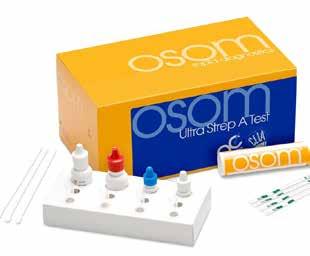
The OSOM® Ultra Strep A test is a color immunochro matographic assay intended for the qualitative detection of Group A Streptococcus antigen directly from throat swab specimens. Shown to be not statistically different than single swab culture. Sensitivity 95.7% and 100% Specificity. Includes two additional test sticks for External QC. CLIA Waived..
View Brochures, Videos & More at POR.io Enter Number 2021 in the Search Area
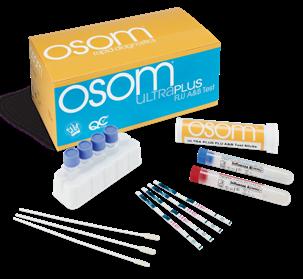
From Abbott
With reduced budgets, shrinking laboratory space and staffing challenges, many laboratories need a solution that lets them work smarter with less. The CELL-DYN Emerald 22 AL is a full performance, automated optical 5-part differential analyzer that delivers smarter results for small to midsize clinical laboratories.
• Compact Design
• Walkaway Functionality
• Ease Of Use
• Smart Safety Features
View Brochures, Videos & More at POR.io Enter Number 2023 in the Search Area
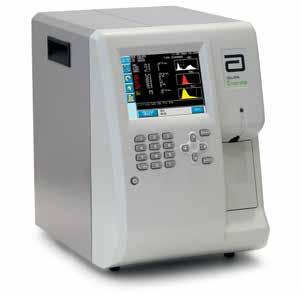
From HORIBA Medical
Is it viral or bacterial? A CBC with 3-part differential can provide the clues to help distinguish between viral and bacterial infections before you decide to treat. The Micros 60 Hematology analyzer provides a CBC with 3-part Diff result in less than 60 seconds using only 10 µL of sample. Connect to the LiteDM Patient Data Management System for an affordable way to consolidate patient results to one report.
View Brochures, Videos & More at POR.io Enter Number 2022 in the Search Area
2023
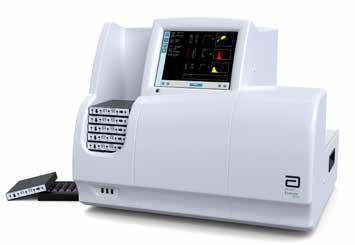
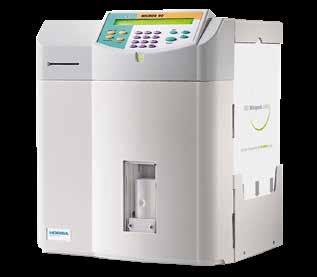
From Abbott
CELL-DYN Emerald is a 3-part differential hematology analyzer that offers high performance in an affordable, compact design that provides reliable and accurate patient results every time. As a smaller operating laboratory, you need a solution that offers reliable results. CELL-DYN Emerald provides results in under 65 seconds. CELL-DYN Emereald’s small size, simple touch screen software and reliability offer an easy-to-use, truly compact table/bench top instrument for easy performance in your laboratory.
View Brochures, Videos & More at POR.io Enter Number 2024 in the Search Area
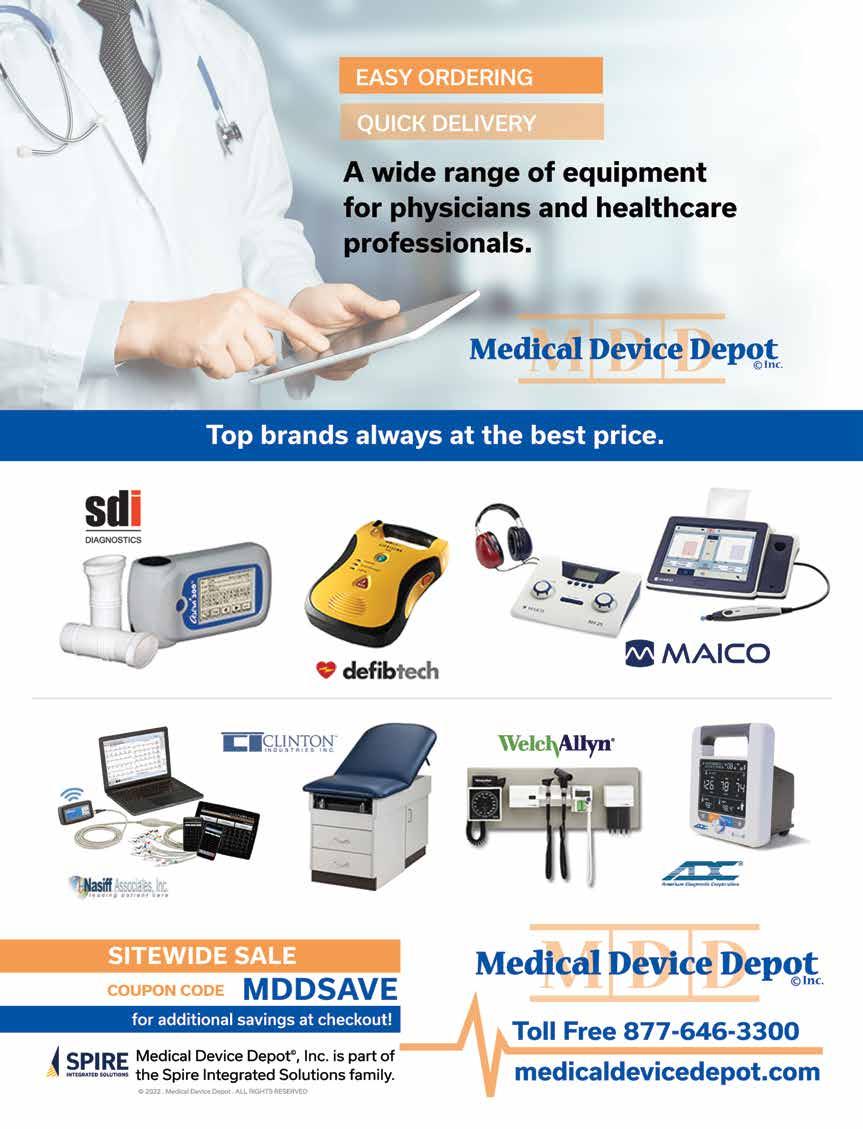
SOFIA® 2 FLUORESCENT IMMUNOASSAY ANALYZER AND RAPID DIAGNOSTIC TEST KITS
From Quidel
Sofia® 2 Fluorescent Immunoassay Analyzer and Rapid Diagnostic Test Kits Sofia 2 takes rapid testing to a new level. Proven lateral-flow technology and advanced fluorescent chemistry are all integrated into this small benchtop analyzer which can be used in any point-of-care setting. Sofia 2 kits are easy to use and adaptable to any healthcare setting. Excellent performance, objectivity, quality control, LIS capabilities, and an expanding test menu make Sofia 2 the perfect solution for the physician’s office laboratory.
View Brochures, Videos & More at POR.io Enter Number 2033 in the Search Area
TOXICOLOGY SCREENING SIMPLIFIED
ABBOTT’S IMMTOX 270 BENCHTOP ANALYZER NOW WITH 14 ASSAYS CLIA CATEGORIZED AS MODERATE COMPLEXITY
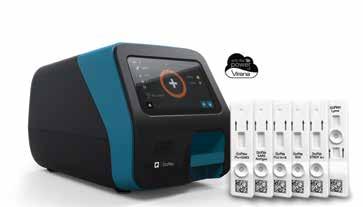

From Abbott
The ImmTox270 benchtop analyzer offers comprehensive toxicology screening solutions for physician offices, treatment centers and independent laboratories.
Broad test menu with over 20 assays to choose from including 14 that are now available as moderately complex.
With complete laboratory solutions from consultation to licensure, and compliance the Abbott Clinical Laboratory Solutions team has you covered.
View Brochures, Videos & More at POR.io Enter Number 2034 in the Search Area 2034
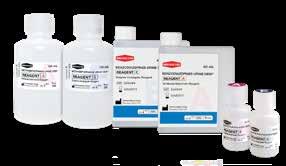
2035
From Abbott
Prescription drug misuse and illicit drug abuse is a growing public health challenge in this country. Building a test profile that covers highly misused drugs has never been so vital. With over 20 relevant assays to choose from Abbott’s suite of Immunalysis reagents allows you to easily screen for relevant substances. Our complete line of assays, calibrators, and controls enables you to implement an efficient drug screening program in office.
View Brochures, Videos & More at POR.io Enter Number 2035 in the Search Area
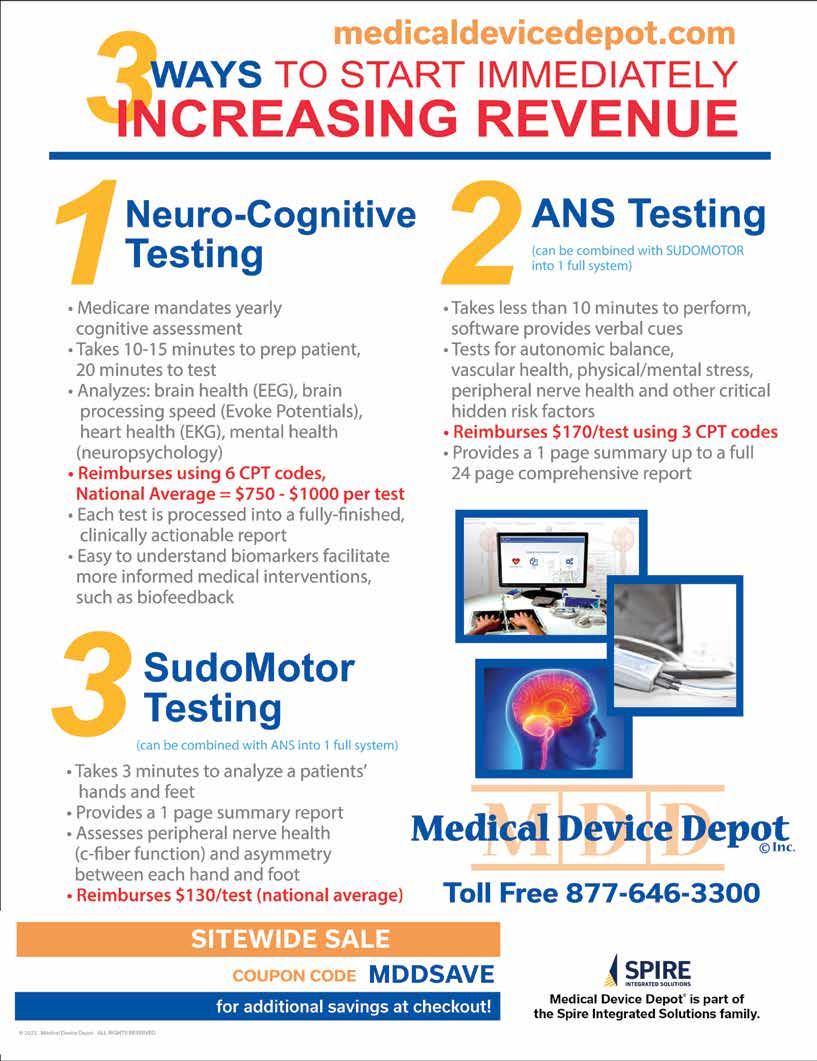
2039
The OSOM® BVBLUE® detects elevated vaginal fluid sialidase activity, an enzyme produced by bacterial pathogens associated with bacterial vaginosis including Gardnerella, Bacteroides, Prevotella and Mobiluncus. OSOM® BVBLUE® is more sensitive than Amsel criteria providing physicians with a more accurate diagnosis to treat and minimize serious health consequences such as early spontaneous preterm births and miscarriage.
View Brochures, Videos & More at POR.io Enter Number 2039 in the Search Area
The OSOM® Trichomonas Rapid Test is intended for the qualitative detection of Trichomonas vaginalis antigens from vaginal swabs or from the saline solution. The OSOM® Trichomonas Rapid Test is a CLIA-waived rapid test available today. OSOM® Trichomonas is more sensitive than wet mount due to the assay being able to detect viable and non-viable organisms which offers significant benefits to the patient and clinician alike.
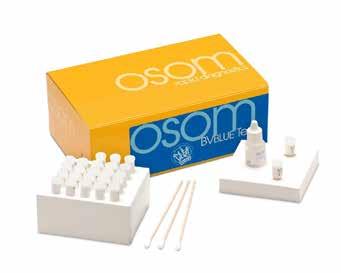

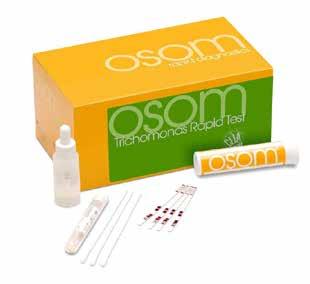
View Brochures, Videos & More at POR.io Enter Number 2040 in the Search Area 2040
The OSOM® Ultra hCG Combo test is a simple immunoassay for the qualitative detection of human chorionic gonadotropin (hCG) in serum or urine for the early confirmation of pregnancy. Internal studies have confirmed that the OSOM® Ultra hCG Combo test does not have a false negative result from hCG variants providing physicians with a higher level of confidence.
View Brochures, Videos & More at POR.io Enter Number 2041 in the Search Area
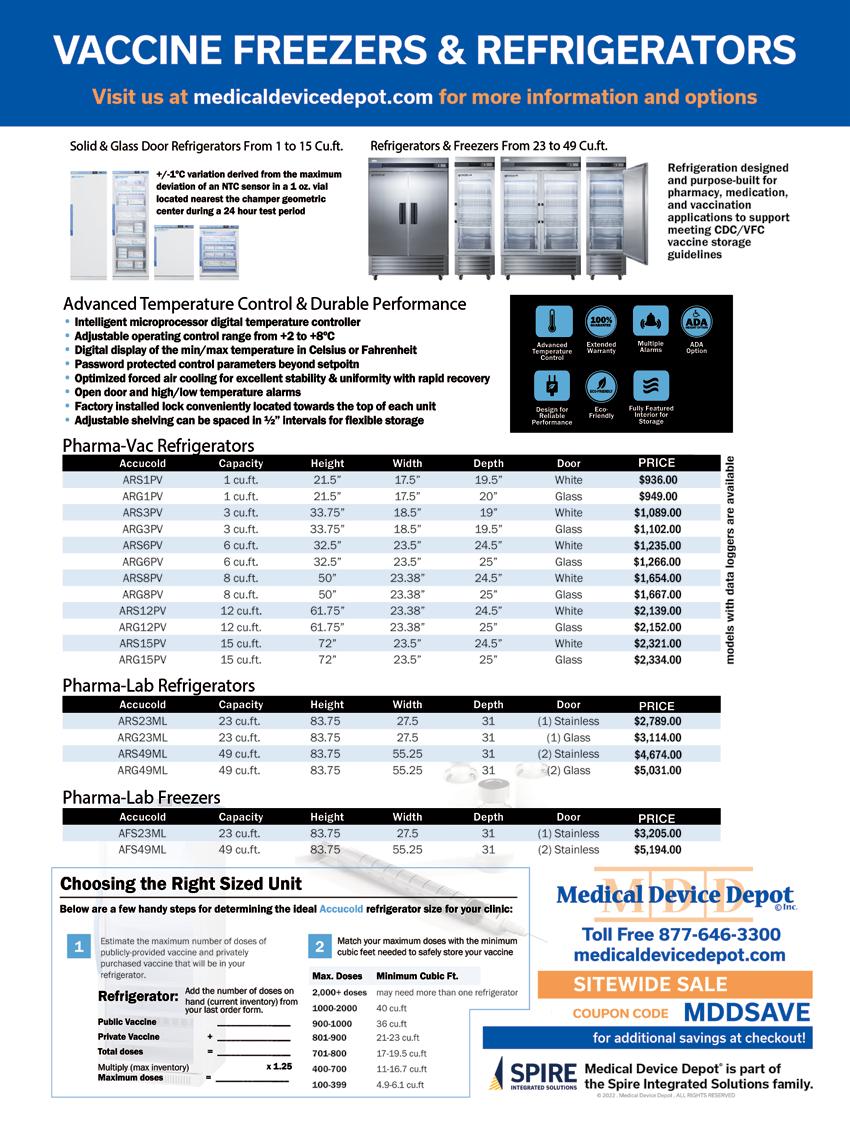

For the average U.S. household, everyday living is getting pricey. Childcare, food, energy, transportation, and housing costs are all rising. Among U.S. physicians and healthcare professionals, personal financial matters may make things tougher given high educational debt-loads, capped income levels during residency years, and unique insurance needs. Furthermore, job-related stressors emanating from clinical and patient-care priorities, administrative duties, continu ing education, licensing requirements, and professional responsibilities leave little time for prudent, active personal financial management.
Self-reported depression and burnout rates are high. In fact, in recent years more than 4 in 10 U.S. physicians report feeling burned out. When asked to rate factors that contribute to depression, results from Medscape’s annu al National Physician Lifestyle Report indicate personal finances ranked second to job/workplace as a contributing factor.
When asked what would reduce their burnout, the number one response from physicians (roughly a third) indicated the best way to combat burnout would be increased finan cial compensation. We want to be paid more. In fact, more money was a more common response than a more manage able schedule.
The circumstances facing a physician’s personal finances present a unique challenge to most in medicine, regardless of specialty. A predominant factor to financial troubles for physicians includes the high cost of education required to become a physician.
According to the AMA, one in four medical students graduates with training-related debt that exceeds $200,000, and half of medical school graduates report debt burdens greater than $150,000. Those financial burdens are com bined with a demanding schedule during graduate medical education and can affect well-being for physician residents and fellows. “Between financial restraints and 80-hour workweeks, trainees often struggle with having the time and budget for necessities. When residency and fellowship programs provide benefits to assist with these needs, it can significantly improve trainee well-being,” said AMA Trust ee Jesse Ehrenfeld, MD, MPH.
some hopeful trends have emerged to address the rising educational debt levels burdening many graduates.
At a handful of US medical schools, financial aid offices have transitioned to financial wellness offices—aiming to better help students with personal financial understanding, housing and living expense considerations, etc.—moving beyond simply providing tuition financing guidance in order to provide holistic financial support and literacy. A great example of this is witnessed at the University of Arkansas for Medical Sciences, where Jason Mizell, M.D., and UAMS faculty have facilitated a popular ‘Business of Medicine’ course since 2012, taught to residents and fourth-year medical students. This course serves to teach early-stage physicians both practice management finance (coding, billing, malpractice, etc.) and, very importantly, personal finance.
Another excellent example of an offering available to medical students is provided by the University of Wiscon sin School of Medicine and Public Health. When medical student Rufus Sweeney struck up conversations with his peers some years ago about their personal finances, he was shocked by how few understood their student debt or even knew about options to pay it off. With a grant from the Wisconsin Medical Society, Rufus joined with Emma Crawford, UW SMPH Director of Financial Wellness and Financial Aid Advising, to develop UW-Madison SMPH’s first ever course focused on physician personal finance. This course continues and remains the most popular elec tive credit offering at the medical school.
While such personal finance educational initiatives ex emplified by UAMS and UW-Madison go a long way to improving financial literacy for young physicians, the trend to educate and empower physicians in the way of personal finances should be prioritized in order to meet cost of liv ing challenges and resultant burnout rates. An introduction to personal finance is a great offering at the medical school level, and—if followed on with subsequent support at each next stage of a physician’s career—would provide a proper runway to financial health and wellness.
Compounding the difficulties, we recognize that the time and attention required to study medicine, biological scienc es, and patient care during training to become a physician leaves little room to acquire a solid education in personal financial management.
personal
Many physicians have access to financial resources early on in their career, but that doesn’t mean they’re confident about their financial situation. At the medical school level,
At the residency level, new expenditure considerations often outweigh the long-awaited first paycheck. Many times, newly minted residents find themselves unprepared to manage a tight budget. A resident may sometimes find financial resources made available as a new employee help ful—though the quality and availability of personal finan cial support is disparate and often inadequate. While the financial picture of a resident includes income, the AMA clearly points out the following: “It takes years to realize your earning potential. As a physician, you will not maxi mize your earnings until the completion of your graduate medical education. The average first-year resident makes around $60,000, (2018 report) and there’s not much wiggle room. Resident salaries are determined by an institution and correlate with training year rather than specialty. So, in a given training institution, all residents who are in their
third year of training get the same salary, and all in their sixth year are paid the same.”
Given the ceiling on income, how many physicians at the resident level have developed the experience and skills to single handedly manage the new challenges to their budget which may stem from debt-repayment, insurance needs, retirement saving, and other important considerations?
Factoring in time constraints and the reasonable desire for a personal life, very few residents have the time to dedicate to getting a handle on personal finances. A host of nega tive consequences may arise if physicians make financial mistakes at these early stages.
Where to start? Where to turn for help? Start simply.
Financial health should be treated in a similar way to attending to physical and mental health. When viewed from this perspective, the training of physicians gives this occupational group an advantage when tackling personal finances.
Let’s outline some simple steps early-career physicians can take to prepare for a healthier financial future:
Become familiar with your financial vital signs While carving out time from a busy schedule may seem impossible, scheduling a bit of time to learn some basics about your individual circumstances is essential. Dedicate some time—think about this as you would think about making an appointment with a doctor. Put it on your calendar.
Begin with some basic information gathering: Identify all sources of household income (review your paychecks, line by line); identify your fixed monthly expenses (hous ing payments, childcare costs, set-aside contributions for savings, etc.), as well as your variable monthly expenses (utilities, subscription services, transportation costs, etc.). As in most things in life, the best first step is figuring out where you are.
Construct a monthly budget
You may think of this step as you would a treatment regi men. Crafting a monthly financial plan that identifies each incoming dollar and prudently purposes each outgoing
dollar will provide a way forward and likely reduce the mental burden of financial unknowns. There are many good budgeting templates and guides. Like finding a good primary care physician, find yourself a budget that you like and works well for you. And like any treatment regimen, stick to your budget in order to achieve good health.
Know your debt repayment options
For the majority of physicians, this step is vital to under stand and implement. One resource worth checking out is provided by Doctored Money, a non-profit serving physi cians that has wonderful debt repayment tools and calcu lators.
Identify support and establish communication Assess your surroundings to locate trustworthy financial resources and fiduciary support, if needed. In many cases, the institution with which you are affiliated may have per sonal financial resources offered. Take advantage of these opportunities when available, if nothing else than to better educate yourself. Once you’ve built a network of profes sionals with whom you can confide, communicate to them as you would with your PCP, remembering that your goal is to limit risks and improve your overall health.
Conduct routine financial check-ups Living within a smartly formulated monthly budget is a winning health strategy, and combined with periodic (quarterly, semi-annual, annual) reviews of your financial vitals will increase your ability to achieve your financial goals. Schedule these reviews on your calendar well in advance, and approach them as you would a visit to any healthcare specialist. Satisfied debts, cost of living adjust ments, salary increases, unexpected expenses, changes in the investable landscape, and other life events will prompt adjustments to your monthly budget. Regular check-ups will help you recognize and appropriately transition your personal finances. Utilize your network of resources and professional support on a regularly scheduled basis.
We’ve been talking a lot about early-career physician groups, but our suggestions are applicable to most, if not all, readers.
Address your financial needs with consistency, and in spite of uncertainties facing the cost of goods and households, we’ll make the U.S. healthcare system a secure, confident foundation for personal and community growth.
When asked what would reduce their burnout, the number one response from physicians (roughly a third) indicated the best way to combat burnout would be increased financial compensation.


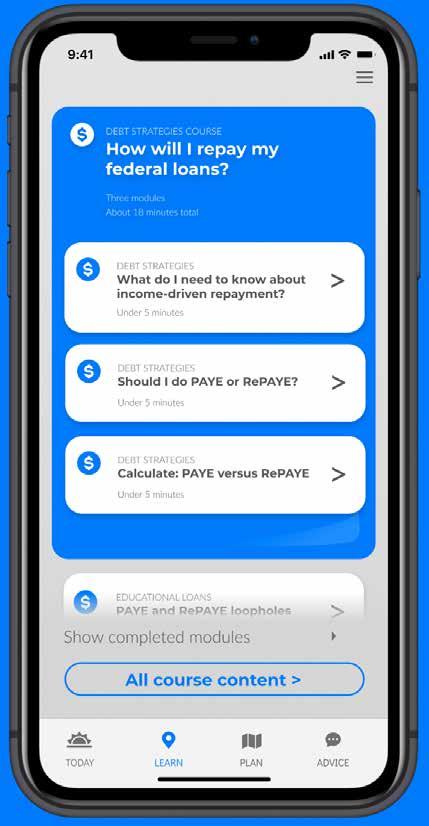
In the time it takes to send samples to a lab, you can test for multiple pathogens onsite, with results in about an hour. The bioMérieux syndromic testing approach uses multiplex PCR technology to test for a comprehensive grouping of targets, giving you accurate results, quickly. Streamline your testing to quickly provide your patients the appropriate treatment with BIOFIRE.
BIOFIRE® RESPIRATORY 2.1-EZ PANEL (EUA)*

For use with the BIOFIRE® FILMARRAY® 2.0 EZ configuration in CLIA-waived settings.
BIOFIRE® FILMARRAY® GASTROINTESTINAL PANEL**
For use in CLIA-moderate settings.
BIOFIRE® JOINT INFECTION PANEL†
For use in CLIA-moderate settings.
*This product has not been FDA cleared or approved, but has been authorized for emergency use by FDA under an EUA for use by authorized laboratories; This product has been authorized only for the detection and differentiation of nucleic acid of SARS-CoV-2 from multiple respiratory viral and bacterial organisms; and, The emergency use of this product is only authorized for the duration of the declaration that circumstances exist justifying the authorization of emergency use of in vitro diagnostics for detection and/or diagnosis of COVID-19 under Section 564(b)(1) of the Federal Food, Drug, and Cosmetic Act, 21 U.S.C. § 360bbb-3(b)(1), unless the declaration is terminated or authorization is revoked sooner. Product availability varies by country. Consult your bioMérieux
results lead to accurate treatment options, onsite in about an hour.